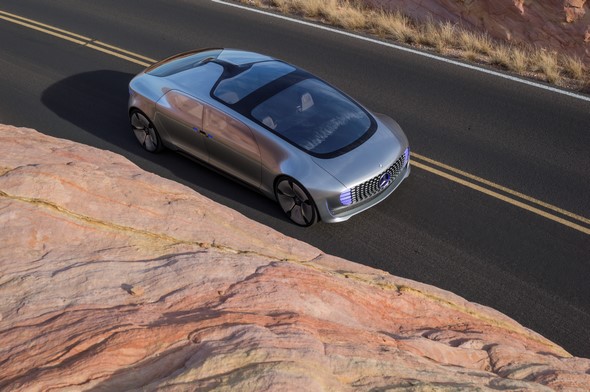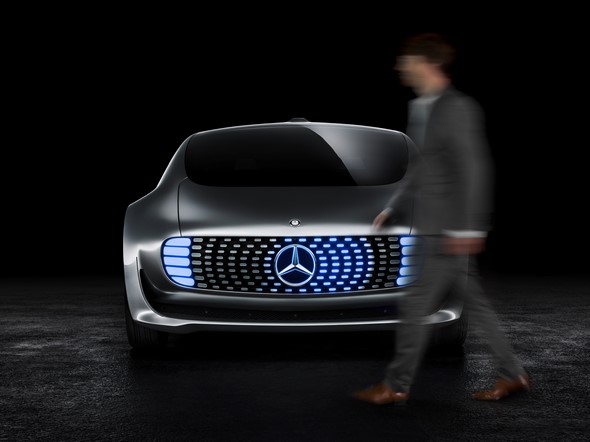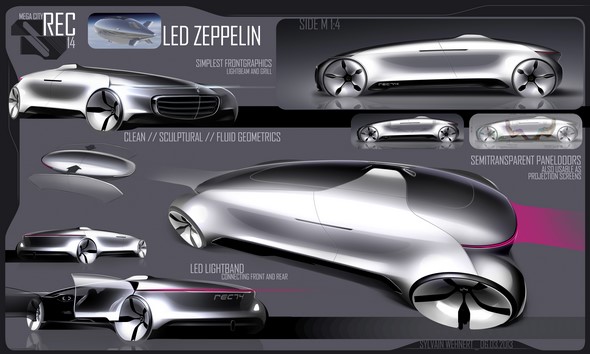Mercedes-Benz F 015 Luxury in Motion
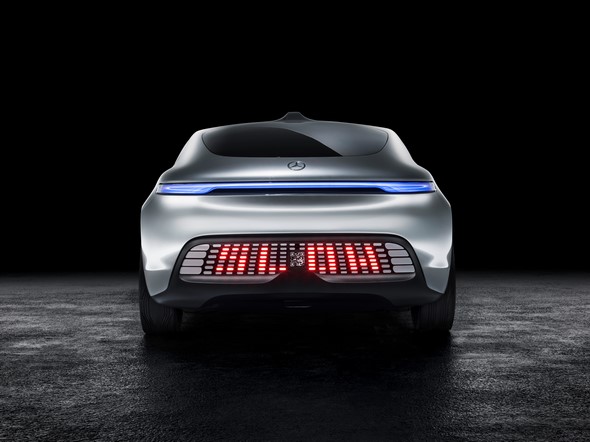
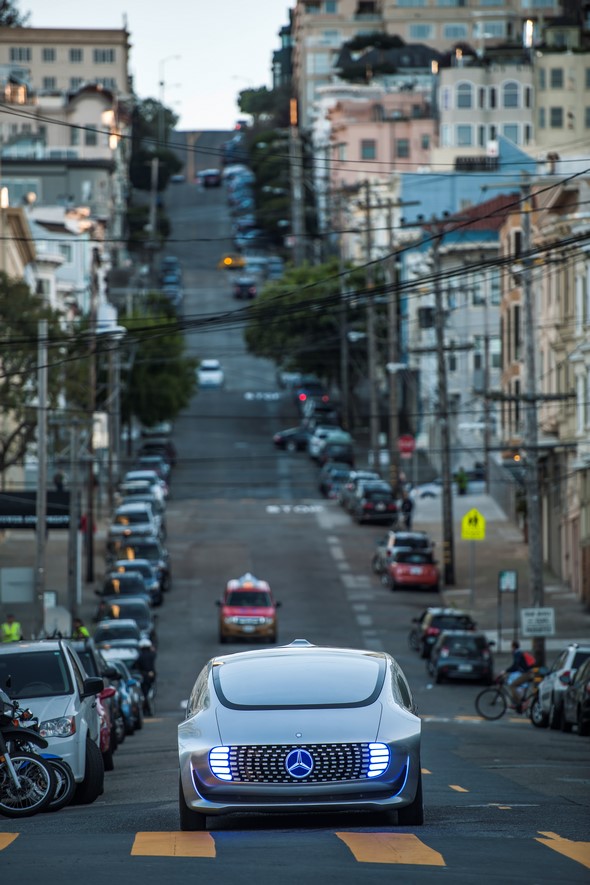
Las Vegas/Stuttgart. With the S 500 INTELLIGENT DRIVE and the Future Truck 2025, Mercedes-Benz has already made the vision of autonomous driving become reality.
The new research vehicle F 015 Luxury in Motion has its world premiere at the Consumer Electronics Show, and provides a concrete example of the visionary ideas the company is developing with regard to autonomous driving of the future.
With this self-driving luxury saloon Mercedes-Benz illustrates how the car is growing beyond its role as a mere means of transport and will ultimately become a private retreating space.
This new way of travelling gives passengers the freedom to use their valuable time on the road in manifold ways.
Progressing from the self-propelled (“automotive”) to the self-reliant (“autonomous”) vehicle, Mercedes-Benz as a pioneer goes far beyond the purely technical realisation of automated driving.
The company’s experts also have to anticipate different outlooks and social trends. People are always at the centre of such considerations.
Just as the 1886 Benz Patent Motor Car and its successors revolutionised personal mobility and, as a consequence, society as a whole, the first self-driving cars will also bring about major changes.
“Anyone who focuses solely on the technology has not yet grasped how autonomous driving will change our society.
The car is growing beyond its role as a mere means of transport and will ultimately become a mobile living space,” explains Dr Dieter Zetsche, Chairman of the Board of Management of Daimler AG and Head of Mercedes-Benz Cars.
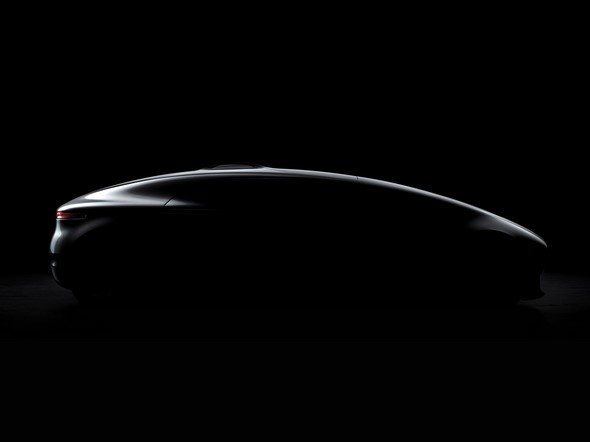
Expressive forerunner of a mobility revolution
With the huge amount of space in its lounge-like interior, the Mercedes-Benz F 015 Luxury in Motion takes the concepts of comfort and luxury to a new level.
Every facet of the vehicle reflects perfectly the Mercedes way of interpreting the terms “modern luxury”, emotion and intelligence.
This innovative four-seater is a forerunner of a mobility revolution, and this is immediately apparent from its futuristic appearance.
It is obvious that the F 015 represents the vision of a brand new vehicle concept just from its unusual proportions (length/width/height: 5220/2018/1524 millimetres), its seamless, monolithic exterior and its large LED light modules at the front and rear.
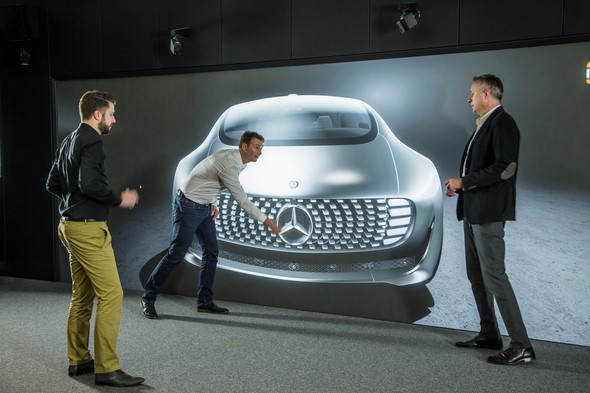
A range of different lighting functions can be provided through these LED fields. At the same time, the vehicle communicates and interacts with the outside world by means of the LED fields.
These LED fields show for example, if the F 015 is driving autonomously (blue) or is controlled manually (white).
The low-slung front end, smooth and streamlined roof line, flat front windscreen and road-hugging rear end give the F 015 Luxury in Motion an extended and decidedly dynamic silhouette.
The F 015 Luxury in Motion’s unusually large wheelbase of 3610 millimetres in combination with its short overhangs clearly show that the design focus was on providing the maximum possible space for the passengers.
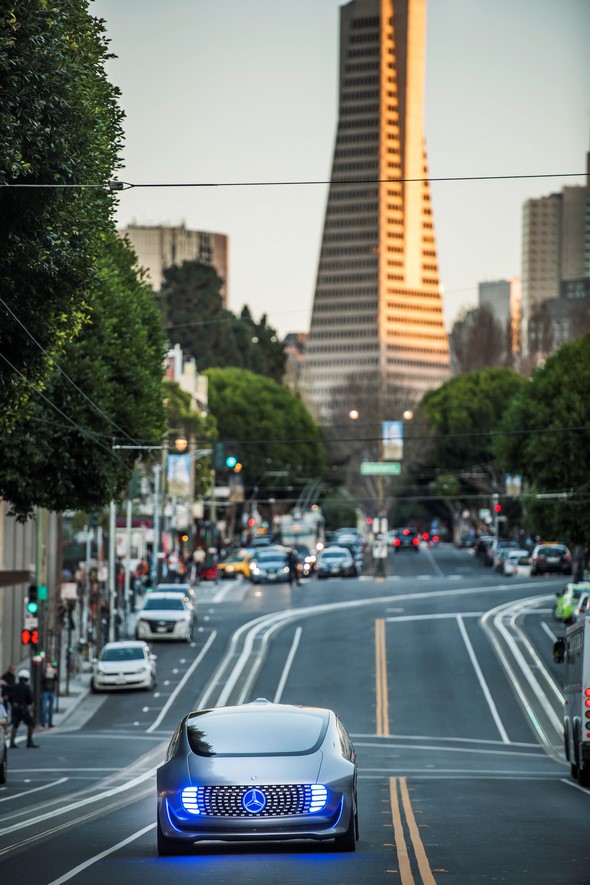
A lounge-like interior with an atmosphere of well-being
In the interior of the F 015 Luxury in Motion the designers have created a lounge-like space with a feel-good ambience characterised by elegance, quality and lightness.
Sensual, flowing transitions and warm, organic materials such as open-pore walnut wood shaped into a three-dimensional veneer, and extremely soft ice white nappa leather contrast with clearly-defined metal and glass surfaces with a cool and technical feel.
The pivotal feature of the innovative interior concept is the variable seating system, with four rotating lounge chairs that allow a face-to-face seat configuration.
In order to make getting in and out of the car easier, the electrically powered seats also swing outwards by 30 degrees as soon as the doors are opened.
If necessary, the driver and front-seat passenger can also turn their eyes and attention towards the front – a prerequisite for manual driving. To this end the steering wheel extends automatically from the dashboard.
The leather-covered cushions of the lounge chairs are set in curved mounts of highly-polished aluminium. Each seating mount has a contrasting light band of blue LED lights and can also be manually swivelled.
One key aspect of the research vehicle is the continuous exchange of information between vehicle, passengers and the outside world.
This is facilitated by six display screens harmoniously integrated into the instrument panel and the rear and side panels, which turn the interior of the F 015 Luxury in Motion into a digital arena.
Passengers can interact intuitively with the connected vehicle through gestures, eye-tracking or by touching the high-resolution screens.
Sensors recognise the passengers’ hands and offer them user interfaces within convenient reach that present appropriate operating options for each particular situation. Particle streams on the displays visualise the vehicle’s movement.
Revolutionary vehicle structure
The high-strength body of the F 015 Luxury in Motion ensures optimum safety and supreme comfort for its passengers.
At the same time, the bodyshell’s structure provides the ideal basis for the door concept that makes getting in and out especially easy, and for the communication-oriented seating featuring four lounge chairs in a face-to-face arrangement.
New materials and structures were used to develop the highly efficient “Smart Body Structure (SBS)” of the F 015.
By cleverly combining carbon-fiber-reinforced plastic (CFRP), aluminium and high-strength steels in a way that matches the varying requirements exactly, the lightweight engineering experts were able to make the bodyshell 40 percent lighter compared with today’s production vehicles.
Another key element of the body design concept is the innovative saloon-door-style door system featuring rear-hinged rear doors.
The front and rear doors can be opened and closed independently of one another. With an opening angle of 90 degrees for all doors, the spacious interior can be easily and comfortably accessed on both sides.
B-pillars were not needed. A very sturdy interconnected system with mechanical locking elements ensures exemplary safety standards.
These elements securely interlock the front and rear doors when they are closed at the same time as fixing them firmly to the roof frame and side skirts.
The resulting composite load path allows an extremely high amount of energy to be absorbed in the event of frontal or side impact, with minimal intrusion into the passenger compartment.
The doors themselves have a crucial role to play in the vehicle’s passive safety concept. The crash-responsive beltlines underneath the side windows are vital here.
The PRE-SAFE Structure, previously unveiled on the ESF 2009 Experimental Safety Vehicle and now further enhanced, offers maximum safety while taking up minimum space: in a side-on collision, these bodywork elements “inflate” in an instant, just like an airbag, allowing them to absorb as much impact energy as possible.
In addition, the bodyshell of the F 015 Luxury in Motion was designed to allow the impact-protected integration of an electric drive system with fuel cell.
This is based on the pioneering F-CELL PLUG-IN HYBRID system seen in the F 125! research vehicle from 2011, and combines on-board generation of electricity with an exceptionally powerful and compact high-voltage battery.
The pressure tank made from CFRP is designed to store the hydrogen.
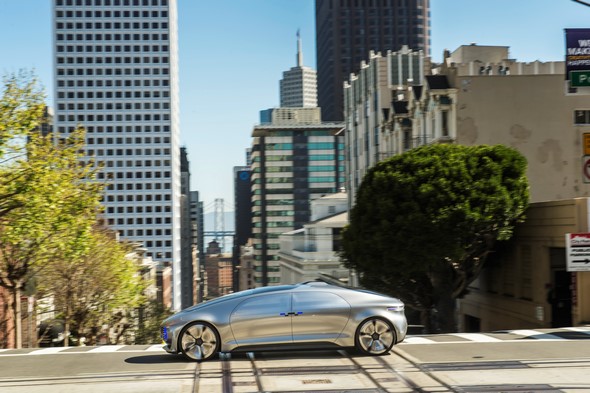
The vision: greater quality of life for all city dwellers
As a foundation for creating the F 015 Luxury in Motion, experts from all areas of Mercedes-Benz developed a future scenario entitled “City of the Future 2030+”, which considered many aspects of mobile living.
The greater the advance of urbanisation, the greater is the desire of the individual to be able to retreat to a private sphere. Autonomous driving will become a given.
As drivers are relieved of work and stress in situations in which driving is not enjoyable, the time gained while in their car takes on a whole new quality. Time and space will become the luxury of the future.
New technologies and forms of communication open up numerous new possibilities for interaction, both between the vehicle and its passengers and between the vehicle and other road users.
Autonomous cars also open up new possibilities for urban infrastructure design. Following the example of today’s low-emission zones in city centres, special “safety zones” that are only accessible to autonomous vehicles could be created. Urban space would be regained by autonomous vehicles parking themselves on the periphery.
In the shared space of the future, humans and machines share the roads. The “car-friendly city” is transformed increasingly into the “people-friendly city” without any loss of individual freedom.
The divide between residential, recreational and traffic areas therefore melts away. The result is superior quality of life for all urban dwellers.
The road to autonomous driving
Even now, vehicles from Mercedes-Benz are capable of detecting many different hazardous situations out on the road and reacting as the situation demands – by means of autonomous braking, for instance.
And from the C-Class through to the S-Class, there are already Mercedes-Benz models driving semi-autonomously on public roads today, equipped with features such as DISTRONIC PLUS with Steering Assist and the Stop&Go Pilot semi-autonomous traffic jam vehicle following function.
Active Parking Assist with PARKTRONIC allows automated parking with active steering and brake control in both parallel and end-on spaces.
In August 2013, Mercedes-Benz demonstrated to great effect that autonomous driving is possible now.
The close-to-production Mercedes-Benz S 500 INTELLIGENT DRIVE completed the approximately 100-kilometre journey from Mannheim to Pforzheim fully autonomously, following the route Bertha Benz took in 1888 on the first ever long-distance drive by car.
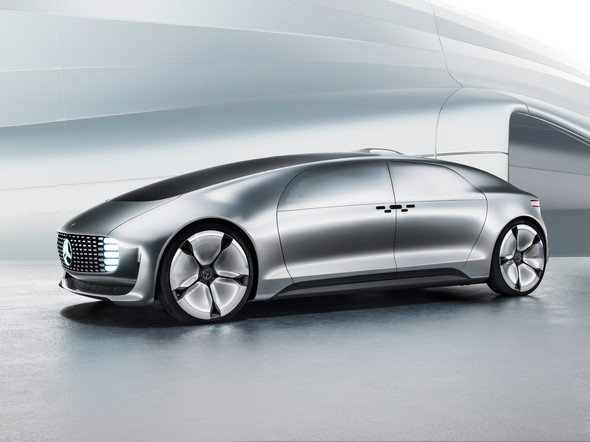
Mercedes-Benz is setting the pace of development in the area of trucks, too – as the innovator and launcher of intelligent assistance systems.
With its Future Truck 2025, the brand presented the world’s first truck to feature autonomous driving at the IAA Commercial Vehicles in September 2014.
In July 2014, this one-off vehicle, based on the Mercedes-Benz Actros 1845, drove at speeds of up to 80 km/h in realistic traffic situations on a section of the A14 autobahn near Magdeburg.
As a global company, Mercedes-Benz has its sights set on autonomous driving worldwide.
In order to factor in the differences in traffic and infrastructure in other markets, the experts also carry out testing in the USA, for example.
In mid-September 2014, Mercedes-Benz became one of the first automotive manufacturers to be issued with an official licence by the US state of California for testing self-driving vehicles on public roads there.
In addition the company makes use of the USA’s largest test facility, the Concord Naval Weapons Station (CNWS).
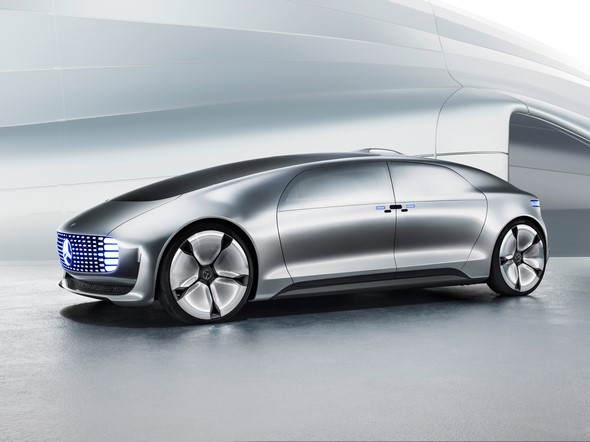
The Mercedes-Benz management team on the F 015 Luxury in Motion
“The car is becoming a mobile living space”
“Anyone who focuses solely on the technology has not yet grasped how autonomous driving will change our society. The car is growing beyond its role as a mere means of transport and will ultimately become a mobile living space.”
Dr Dieter Zetsche, Chairman of the Board of Management of Daimler AG and Head of Mercedes-Benz Cars
“Autonomous driving is one of the greatest innovations since the invention of the motor car. Drivers are relieved of work and stress in situations in which driving is not enjoyable, and the time gained while in their car takes on a whole new quality.”
Prof Dr Thomas Weber, Member of the Board of Management of Daimler AG, responsible for Group Research and Head of Mercedes-Benz Cars Development
“Visionary concepts as the F 015 are vital for fueling the social discourse on mobility and the design of urban habitats. An essential part of our culture of innovation is to make humans, with their needs and desires, the central focus of our considerations and developments. ”
Prof Dr Herbert Kohler, Head of Corporate Research & Sustainability and Chief Environmental Officer for Daimler AG
“With the F 015 Luxury in Motion we wanted to design a luxurious vehicle with a lounge-like ambience in the interior, which combines sensuality with purity in a very special way and appeals equally to the intellect and to the emotions, thereby exerting a natural appeal. In addition, its exterior had to signal its visionary and pioneering character at first glance.”
Gorden Wagener, Vice President Design Daimler AG
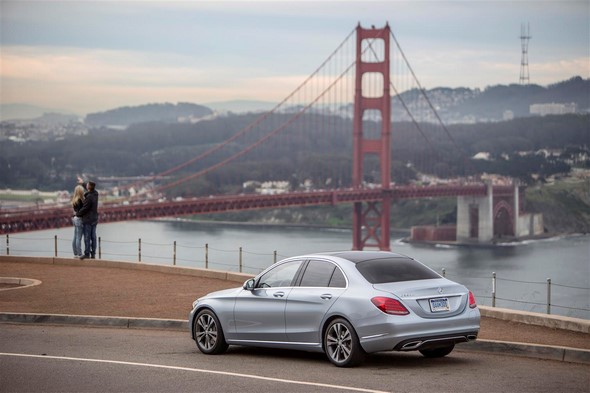
Mercedes-Benz’s “Intelligent Drive” philosophy
Intelligence = efficiency
Stuttgart/San Francisco. At Mercedes-Benz “Intelligent Drive” stands for the networking of systems, sensors and algorithms for enhanced comfort and safety.
The drive system also benefits from the increasing level of intelligence on board vehicles.
Following the Mercedes-Benz S-Class PLUG-IN HYBRID, the new Mercedes-Benz C 350 e provides a further example of dynamism and efficiency combined in impressive guise.
The anticipatory operating strategy opens up a new dimension in driving.
And the autonomously driving research car F 015 Luxury in Motion heralds a revolution in mobility, showing how “Intelligent Drive” might look like in the future.
Numerous new systems and sensors make Mercedes-Benz vehicles even more comfortable and even safer – and even more efficient and dynamic, too, as the intelligent operating strategy of the new Plug-In Hybrid controls the ideal interaction of combustion engine and electric motor in the background.
The strategy not only adapts to the battery’s charge status, but also anticipates the course of the road or the traffic situation.
The enhanced vehicle sensing technology featuring multi-stage radar sensors and enhanced cameras is employed for this purpose.
Intelligent innovations such as the so-called haptic accelerator pedal additionally help the driver to save fuel in certain driving situations.
“Every Mercedes-Benz already incorporates a great deal of intelligence. This makes our cars among the safest in the world.
And the drive system also benefits from the intelligent sensor technology on board. The anticipatory operating strategy spawns noticeable improvements in the efficiency of plug-in hybrids, for example,” says Prof. Dr Herbert Kohler, Head of Group Research & Sustainability at Daimler AG.
Mercedes-Benz will be launching ten new Plug-In Hybrid models until 2017 – on average one new model with this high-tech hybrid drive every four months.
After the successful launch of the S 500 PLUG-IN HYBRID, this month will see the C 350 e, the second model to feature the progressive drive concept, find its way to dealerships.
And what might happen next with the strategic hybrid initiative has just been demonstrated by the Concept V-ision e study at the Geneva Motor Show.
The Plug-In Hybrid system is based on the company’s modular parallel hybrid system. The common system-specific feature is the additional clutch integrated between the combustion engine and the electric motor.
On the one hand this decouples the combustion engine during purely electric operation, while on the other it allows the vehicle to use the combustion engine to move off, drawing on the performance of a wet start-up clutch.
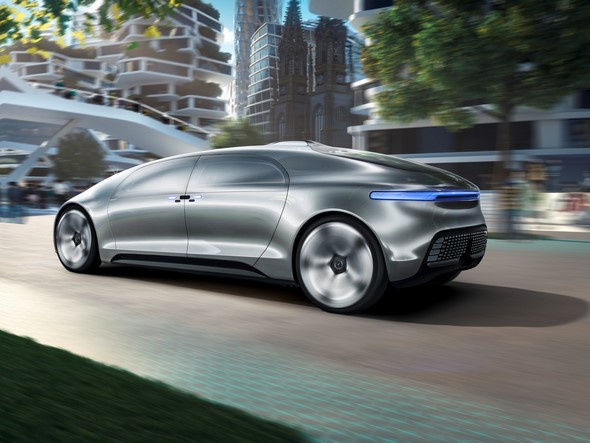
“Intelligent Drive” today and tomorrow
Thanks to “Intelligent Drive”, vehicles from Mercedes-Benz are already able to detect many hazardous situations in road traffic and react as the situation demands.
COLLISION PREVENTION ASSIST is on board as standard from the A to the S-Class, for example. This radar-based assistance system warns the driver when a risk of collision arises.
And the more advanced COLLISION PREVENTION ASSIST PLUS system, becoming available over all models from Mercedes-Benz, is even able to carry out autonomous braking: if the driver fails to act when a risk of collision is detected, despite the warning lamp in the instrument cluster and the intermittent acoustic alert, the system will automatically trigger braking.
Beyond this, from the C-Class through to the S-Class there are already Mercedes-Benz models driving semi-autonomously on public roads today, equipped with features such as DISTRONIC PLUS with Steering Assist and the Stop&Go Pilot for semi-autonomous traffic jam following.
Active Parking Assist with PARKTRONIC allows automated parking with active steering and brake control in both parallel and end-on spaces.
With its autonomously driving research vehicle F 015 Luxury in Motion, Mercedes-Benz provides an idea of what form “Intelligent Drive” might take in the future.
The car’s role is evolving from merely a means of transport towards that of a comfortable retreat, too. Drivers can choose at any time whether they wish to drive themselves, with support of intelligent systems or whether the car is to take them to their destination in autonomous mode.
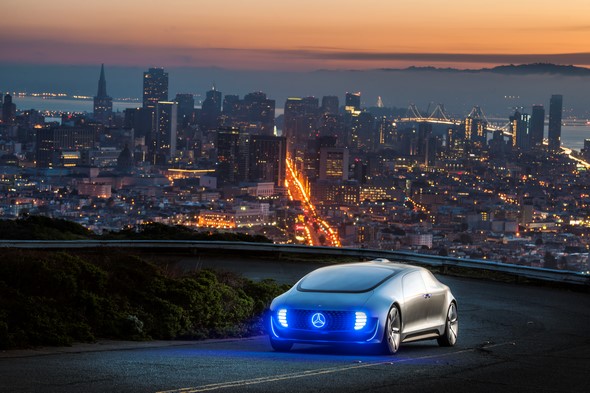
Time spent in the car thus acquires a totally new quality – as a result of the freedom to concern oneself with matters other than steering, accelerating and braking.
Six high-resolution displays are installed along the interior, in the dashboard, the back and sides of the car. The passengers are able to interact with the F 015 by eye-tracking, gesture control or touching the screens.
They get information about the environment, use the entertainment system, make video calls or bring virtual worlds into the car.
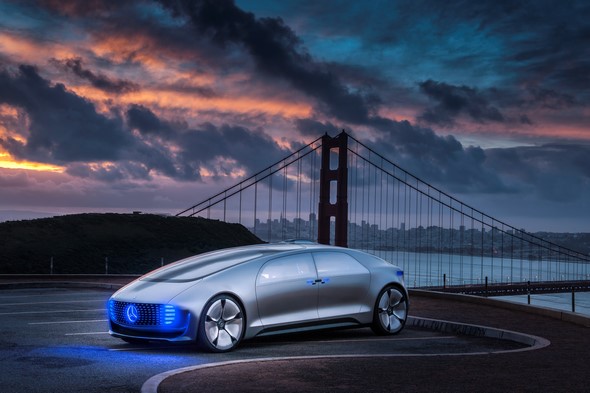
The primary feature of the innovative interior concept is the variable seating system, with four rotating lounge chairs.
Through the face-to-face configuration all passengers are able to communicate with each other and enjoy the mobile living space while being driven.
The F 015 also incorporates high-resolution sensor technology which continuously scans the vehicle’s surroundings, ensuring effective communication and interaction between the vehicle, the passengers and the world outside.
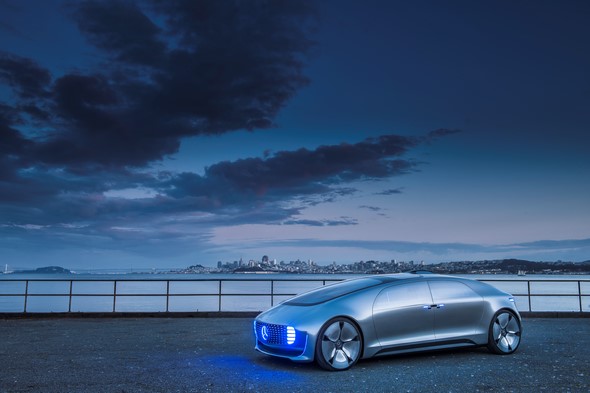
This ‘extended sense’ enables the vehicle to keep tabs on its surroundings at all times.
The interactive LED fields at the front and rear and the high-precision laser system informs the driver of specific traffic conditions at an early stage. For instance, the
F 015 is able to project a virtual crosswalk onto the road surface which lets the pedestrian know the road is clear. The F 015 becomes a reliable and intelligent partner in road traffic.
“City of the Future 2030+” vision
Shared space in tomorrow’s world
- F 015 Luxury in Motion in the city traffic of the future
- Mercedes-Benz provides technically feasible and socially desirable solutions to the challenges of mobility
In order to provide a foundation for the new autonomous F 015 Luxury in Motion research vehicle, an interdisciplinary team of experts from Mercedes-Benz has devised a future scenario that incorporates many different aspects of day-to-day mobility.

Above and beyond its mobility function, this scenario perceives the motor car as a private retreat that additionally offers an important added value for society at large.
“Anyone who focuses solely on the technology has not yet grasped how autonomous driving will change our society,” emphasises Dr Dieter Zetsche, Chairman of the Board of Management of Daimler AG and Head of Mercedes-Benz Cars.
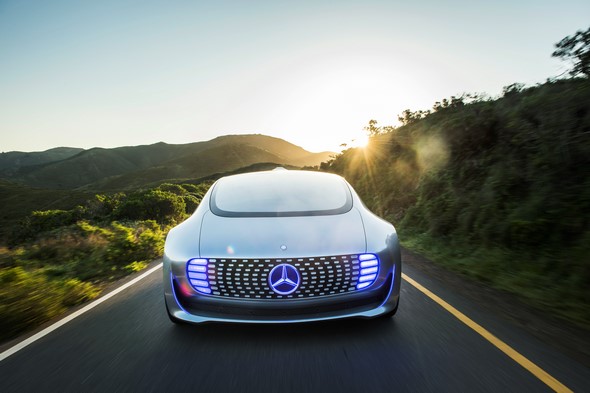
“The car is growing beyond its role as a mere means of transport and will ultimately become a mobile living space.”
In the same way the 1886 Benz Patent Motor Car and its successors revolutionised personal mobility and, as a consequence, society as a whole, the first self-driving cars will also bring about major changes.
Visions are vital for fuelling the social discourse on future mobility and the design of urban habitats, as is seeing things from an all-encompassing perspective.
Not just crystal ball gazing
The “City of the Future 2030+” vision: urbanisation has continued to advance, and the little urban space there is today is scarcer than ever.
In an urban environment where space is at a premium and everything happens at a hectic pace, people have a growing desire for privacy and a place to retreat to.
Autonomous driving is taken for granted – it is accepted by society and the technology is perfectly reliable.
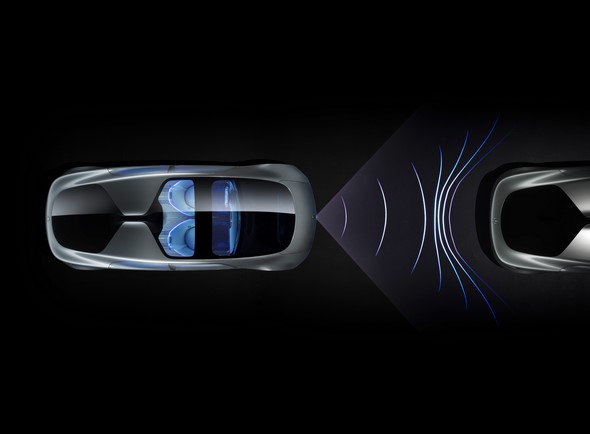
As the autonomous car takes over from the driver in situations where driving isn’t much fun, such as slow-moving traffic, it gives real added quality to time spent out on the road.
The passengers in self-driving cars use their newly gained free time while travelling for relaxing or working as they please.
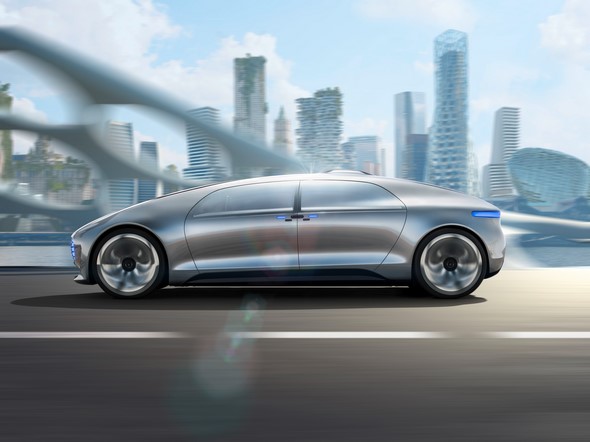
New technologies and forms of communication open up a whole host of new possibilities for interaction, both between the vehicle and its passengers and between the vehicle and other road users.
The relationship between human and car is configured in such a way that the autonomous car assumes those tasks the human does not wish to carry out or cannot carry out, such as maintaining a permanent 360-degree all-round view.
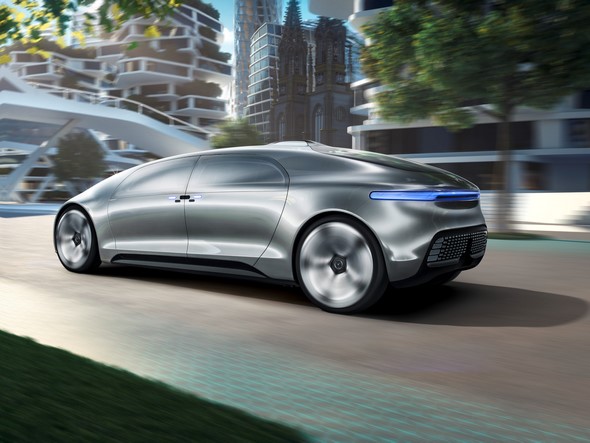
The human, on the other hand, decides how fast the car should move or which route is more scenic.
The result is a new form of ‘teamwork’ between vehicle and driver that will make people’s lives easier.
New scope for designing the urban infrastructure
Autonomous cars also open up new possibilities for urban infrastructure design. The streetscape is set to change.
Following the example of today’s low-emission zones in city centres, special “safety zones” that are only accessible to autonomous vehicles could be created.
The removal of surplus streets and road signs could furthermore free up valuable space in the densely populated megacities.
Urban space would also be regained by autonomous vehicles parking themselves on the periphery.
This alone could eliminate around a third of the city traffic produced today by vehicles searching for a parking spot.
Extensive connectivity and communication would allow traffic composed of autonomous vehicles to flow more smoothly and take up fewer lanes.
Traffic would become more free-flowing again as a result of vehicles moving continuously. Overall, personal mobility would be more comfortable, more stress-free and safer.
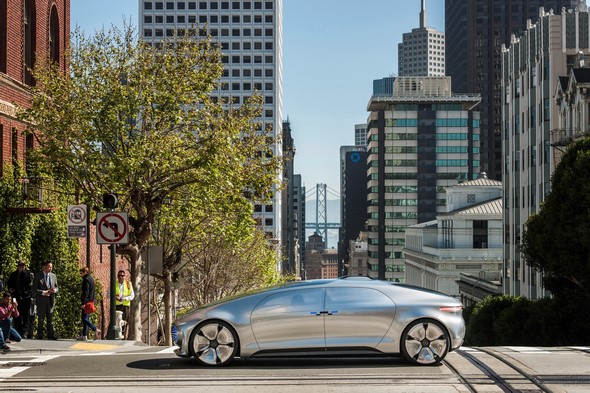
Shared space in tomorrow’s world
In the shared space of the future, humans and machines share the roads. The “car-friendly city” is transformed increasingly into the “people-friendly city” without any loss of individual freedom and the possibility to use the car.
Main access roads in the cities that were previously busy with traffic become attractive places for living, shopping and strolling again.
The divide between residential, recreational and traffic areas therefore melts away. The result is superior quality of life for all urban dwellers.
The technology will also offer older people and people with disabilities who are not able to drive themselves the opportunity to enjoy personal mobility.
Beyond the high-density urban areas with “safety zones”, there will be mixed traffic where self-driving vehicles use the roads together with conventionally driven cars.
The extensive sensor systems and communication facilities will yield substantial benefits for all road users.
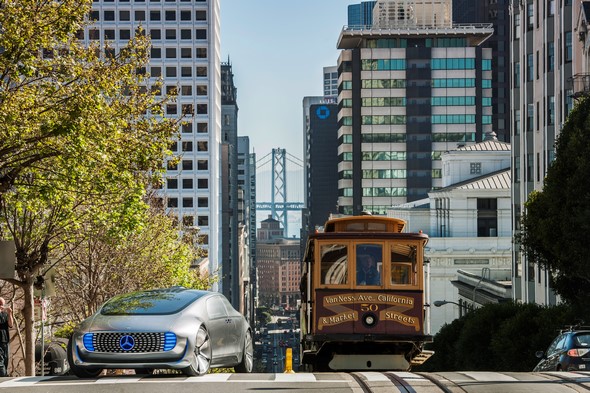
Mercedes-Benz experts engaged in a dialogue on the future of mobility
Mercedes-Benz regularly invites interested parties to take part in a dialogue on the future of mobility.
For example, the Future Talk introduced by Mercedes-Benz in 2013 established a new dialogue format and asked the question “How utopian is the future?” In dialogue with the avant-garde in different disciplines, Mercedes-Benz experts shared their visions of shaping a desirable mobile future.
The focus of the Mercedes-Benz Future Talk “Robotics” in July 2014 was the interaction between man and machine.
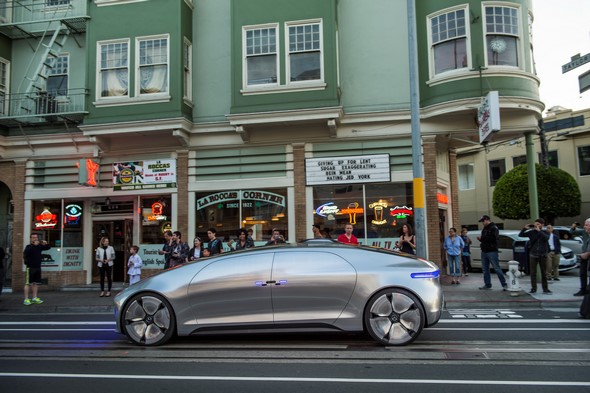
Interview with Thomas Weber and Herbert Kohler
“Autonomous driving is one of the greatest innovations since the invention of the motor car”
- Vision 2030+: autonomous driving becomes part of day-to-day mobility
- New driving culture allowing good use to be made of time spent in the car
- More than eye contact: trust between human and machine
Since the early 1970s, Mercedes-Benz has unveiled more than a dozen visionary research vehicles. Numerous technological features have already found their way into series production.
With the new F 015 Luxury in Motion, Mercedes-Benz is once again underlining the pioneering role it plays in the development of visionary automotive concepts. The focus this time has been clearly placed on autonomous driving.
Progressing from the self-propelled (“automotive”) to the self-reliant (“autonomous”) car takes Mercedes-Benz research and development far beyond the purely technical implementation of automated driving.
The company’s experts also have to anticipate different outlooks and social trends. Humans, with their needs and desires, are always at the heart of their considerations, though.
Prof Dr Thomas Weber, Member of the Board of Management of Daimler AG responsible for Group Research and Mercedes-Benz Cars Development, and Prof Dr Herbert Kohler, Head of Group Research & Sustainability and Chief Environmental Officer for Daimler AG, explain the company’s vision of autonomous driving as well as further steps along the road to revolutionising mobility.
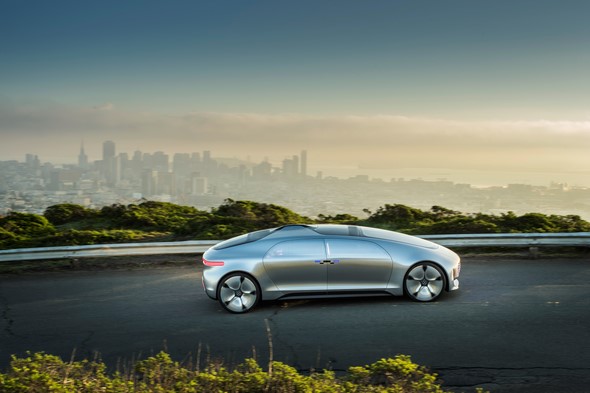
For the first time, the F 015 Luxury in Motion explores the possibilities offered by autonomous driving in depth.
What significance do you see the self-driving car as having?
Prof Dr Thomas Weber: Autonomous driving is one of the greatest innovations since the invention of the motor car.
Drivers are relieved of work and stress in situations in which driving is not enjoyable, and the time gained while in their car takes on a whole new quality: the freedom to do other things while driving instead of steering, accelerating and braking.
Prof Dr Herbert Kohler: That’s exactly how I see it – in a world where space is at a premium and everything happens at a hectic pace, people have a growing desire for privacy and individuality.
So the car becomes a place to retreat to. Autonomous driving offers drivers the freedom of being able to use the time spent in this retreat as they wish.
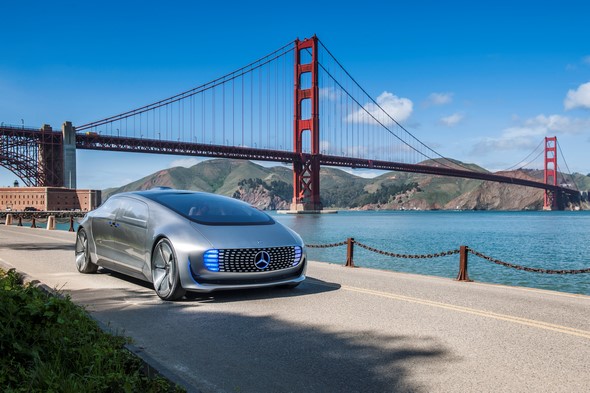
You already demonstrated that autonomous driving is technically possible today in complex, realistic traffic situations, both in the city and when travelling cross-country, in summer 2013 with the S 500 INTELLIGENT DRIVE. What is the purpose of the F 015 Luxury in Motion?
Weber: We see ourselves as pioneers of autonomous driving and are fully committed to pushing ahead with its development consequently.
This means we are very mindful of everything that accompanies this development – including how autonomous driving revolutionises the vehicle interior, for example.
The F 015 makes this aspect even more appealing, as well as making it more comprehensible and tangible for people.
Kohler: Visionary concepts as the F 015 are vital for fueling the social discourse on mobility and the design of urban habitats.
An essential part of our culture of innovation is to make humans, with their needs and desires, the central focus of our considerations and developments.
Needless to say, we use the in-house expertise of our global R&D network for this. However, we also consult avant-gardists and experts from a whole range of different fields.
With the Mercedes-Benz Future Talk, for instance, we inaugurated a series of dialogues in 2013 that are a tremendous source of inspiration for us.
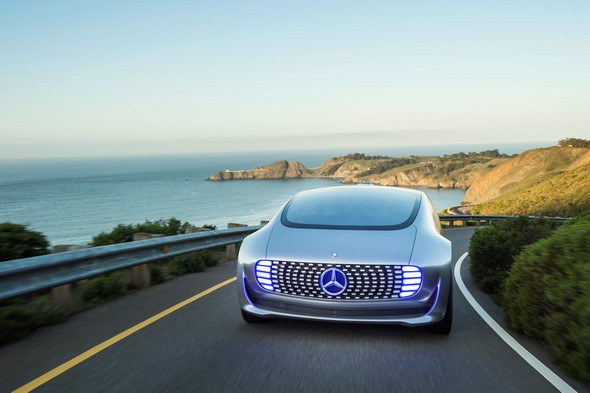
What specific ideas from future scenarios were incorporated into the design of the F 015?
Kohler: Our future scenario looks ahead to the years 2030+. Urbanisation will continue to advance – this is a clearly foreseeable trend worldwide.
The little space there is in our cities today will become increasingly scarce. One quite important thing to note in this regard: autonomous driving will be accepted by society as part of day-to-day mobility.
This will entail both technical and social changes.
Weber: And motoring itself will also change. The Mercedes-Benz F 015 Luxury in Motion demonstrates this to full effect.
This self-driving luxury saloon offers up to four passengers remarkably generous amounts of room. The lounge-style interior is designed as a digital space offering total connectivity.
The occupants can use the time spent aboard the vehicle for relaxing, communicating or working efficiently. This brings a real boost in terms of quality of life.
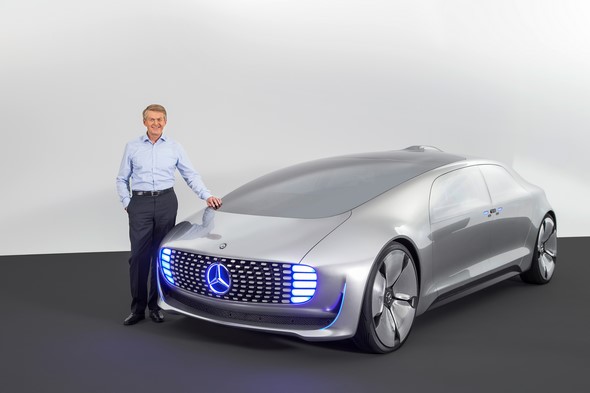
The motor car as a private retreat in the midst of the bustling traffic?
Kohler: Precisely. We see that as being the true luxury of the future. However, we also envisage the motor car giving something back to society and offering added value for the world at large.
The intelligent vehicle can warn other road users of potential hazards, for example, or provide early information on certain traffic situations, thereby having a positive impact on traffic conditions.
Communication and interaction are key to generating this added value.
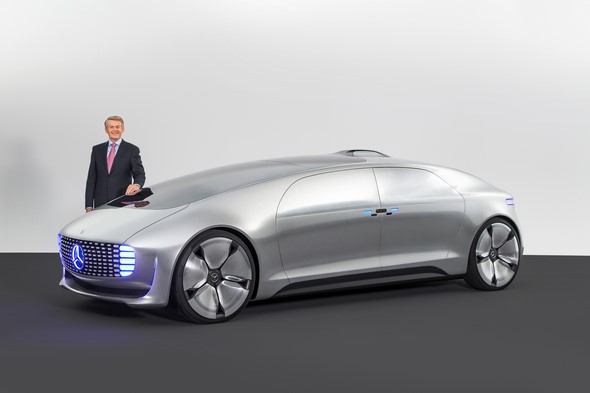
A car that can communicate – it all sounds like a science fiction film. How does it work in reality?
Weber: It’s already reality today, using Live Traffic Information, for instance, or the automatic emergency call.
And actually, it’s not really new at all: even when the indicators are switched on, the driver, or rather the car, is communicating with its surroundings.
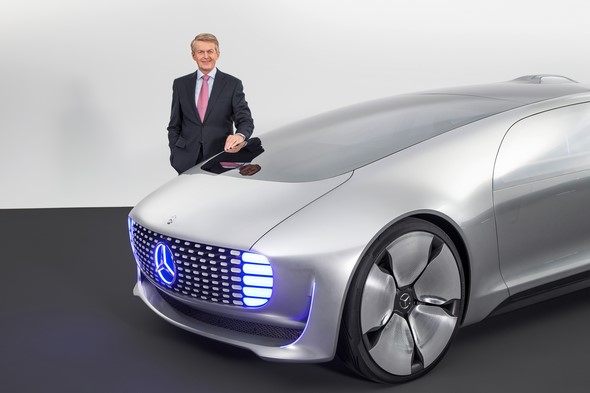
The F 015 is capable of far more, though. It has large communication displays at the front and rear with LED panels.
By changing the colour of the lights, the F 015 indicates, for example, what driving mode it is currently in: blue stands for autonomous and white for manual.
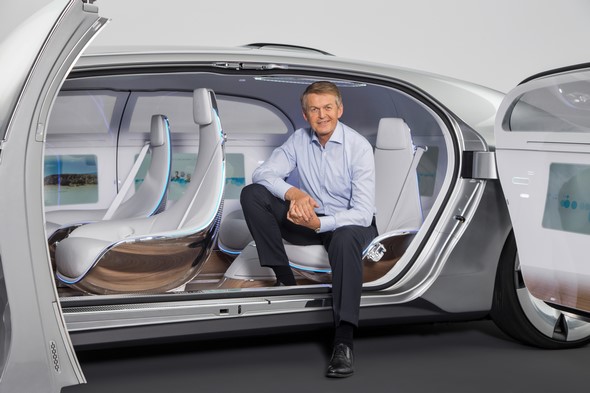
If the F 015 detects a pedestrian at the roadside, undulating light signals appear in the LED grille to show the pedestrian that the vehicle has seen them.
This has the effect of building trust between human and machine, as the traditional eye contact with the driver will no longer exist as we know it today.
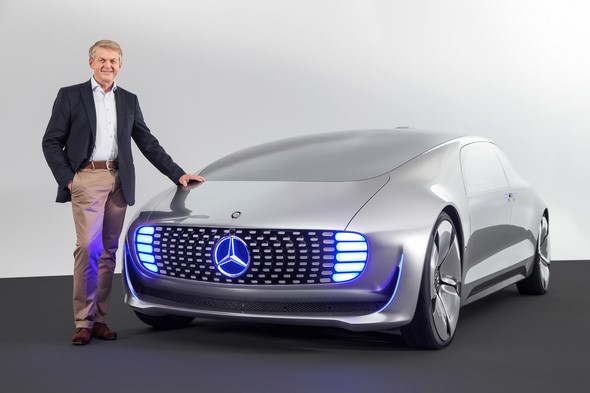
Kohler: Communication is the key. Should a pedestrian wish to cross the road, for instance, the F 015 halts and scans its surroundings to check whether it is safe to do so.
If it is, the car uses a high-precision laser system to project a virtual zebra crossing onto the road surface and additionally lets the pedestrian know it is clear to cross with an audible “Please go ahead” prompt.
Where does the car obtain the necessary information from?
Weber: The F 015 is equipped with an extensive sensor system that allows it to permanently monitor the entire area surrounding it.
Nothing escapes the attention of the stereo cameras, radar and other sensors. Neither do they lose concentration or start to tire.
The vehicle’s complete connectivity furthermore means it is being constantly fed with up-to-the-minute information via the internet – including information on things that are taking place beyond the detection range of its own sensors.
All of this data is amalgamated, evaluated and interpreted appropriately. We call this intelligent sensor fusion.
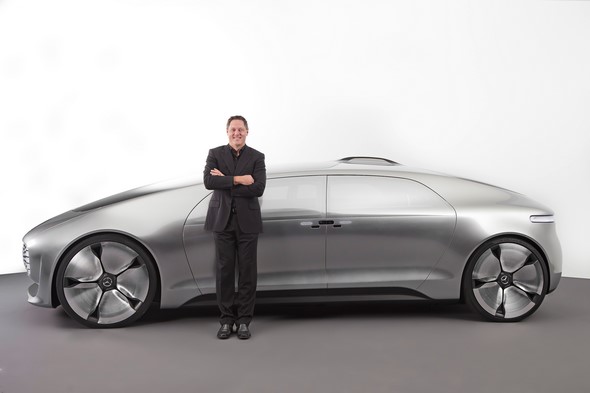
And in what language do human and machine communicate with one another?
Kohler: Interaction in the vehicle interior is intuitive and takes the form of natural gestures, eye-tracking or touch control.
We are also working hard on the development of a universal and perfectly clear form of communication between human and machine outside the vehicle too.
As we see it, the human always remains in charge in all situations.
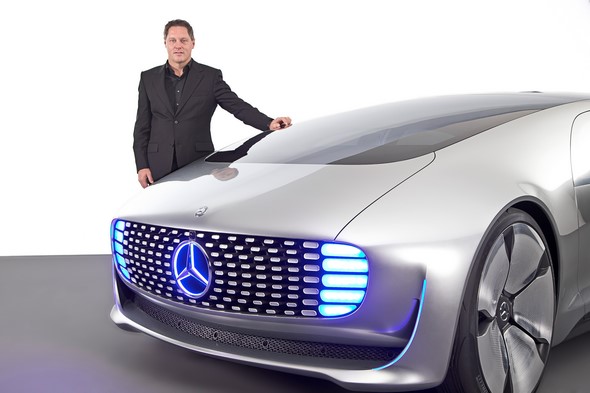
The complete connectivity of the motor car raises questions about data privacy and data security. What does Mercedes-Benz do to ensure that vehicle data is secure?
How would you reassure potential sceptics?
Kohler: We follow a cloud-based approach. In combination with the Daimler Vehicle Backend, a specially secured server, this guarantees a secure and encrypted exchange of data every time.
In the interest of our customers, data privacy and therefore transparency are also very important to us besides data security.
The customers must be aware what data is being collected when and for what purpose, and can decide for themselves what data they wish to release.
There are strict rules and regulations for accessing data, and independent audits are conducted to make sure they are complied with.
Weber: When developing the fully connected car, we paid careful attention to the issue of data privacy right from the start.
The car of the future will turn increasingly into a digital companion, which at the same time means it must keep data safe as well as be perfectly safe to operate out on the road.
This careful and secure handling of data is a vital factor for the general acceptance of the new technologies.
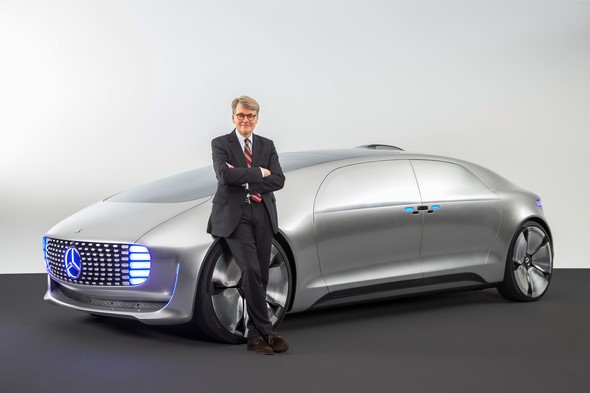
Your last autonomous driving projects – S 500 INTELLIGENT DRIVE and Future Truck 2025 – were both presented in Germany. But surely you want autonomous vehicles to be used worldwide?
Weber: Yes, and that is precisely why we naturally test worldwide to allow us to factor in the varying traffic and infrastructure conditions.
In mid-September 2014, Mercedes-Benz became one of the first automotive manufacturers to be issued with an official licence by the US state of California for testing self-driving vehicles on public roads there too.
In addition to this, we also make use of the USA’s largest test facility, the Concord Naval Weapons Station (CNWS), for further testing of this future technology.
This abandoned military site with its city-like road network extending over an area of 8.5 km2 provides a realistic traffic environment.
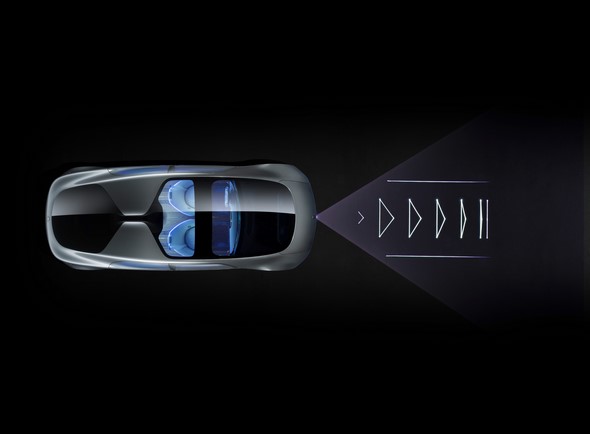
How do things stand in general with the legal requirements for autonomous driving on public roads?
Kohler: They currently differ from country to country, and even from state to state in some cases, especially when you look at the USA.
Things are changing though: last spring, a United Nations expert committee got to work on an amendment to the 1968 Vienna Convention on Road Traffic, thereby creating the basis for legalising autonomous driving.
In future, the corresponding systems should be permitted provided they can be deactivated or overridden by the driver at any time. We are now calling for swift implementation of this amendment to the law and of the appropriate regulations at the national level.
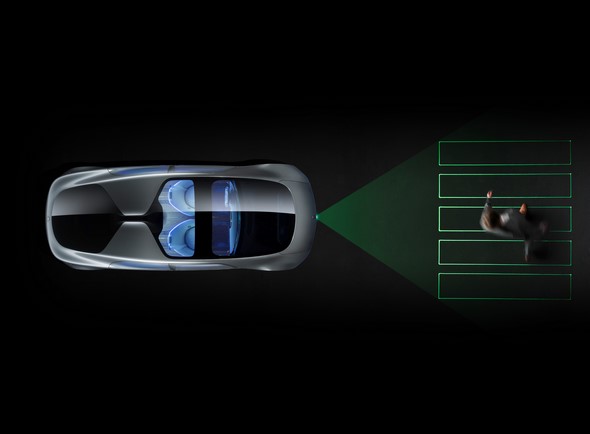
What are the next steps on the road to autonomous driving?
Weber: Autonomous driving will not suddenly happen overnight, rather it will be a gradual development that takes place step by step.
I am absolutely sure that we will be able to offer our customers features such as fully automatic parking and automatic driving on the motorway before the end of this decade.
Kohler: And don’t forget: from the C- and E-Class through to the S-Class, our models already make life easier for the driver today with various semi-autonomous functions.
These include DISTRONIC PLUS with Steering Assist and the Stop&Go Pilot: this allows the car to automatically keep up with the vehicle in front in tailbacks as well as assist with steering too.
Active Parking Assist, meanwhile, selects a suitable parking space and takes care of the steering. The driver only needs to accelerate and brake.
And what about the pleasure of driving?
Weber: That’s simple, it will be greater than ever. You can drive yourself when you want to instead of when you have to.
Anyone who wishes will be able to keep their hands on the steering wheel and still press the accelerator. Driving pleasure cannot be automated.
But another driving culture can evolve alongside it that offers a whole new degree of freedom. In the long run, we will complete the majority of everyday journeys in autonomous mode – comfortably, safely and with the opportunity to put the valuable time spent travelling to efficient use in all sorts of different ways.
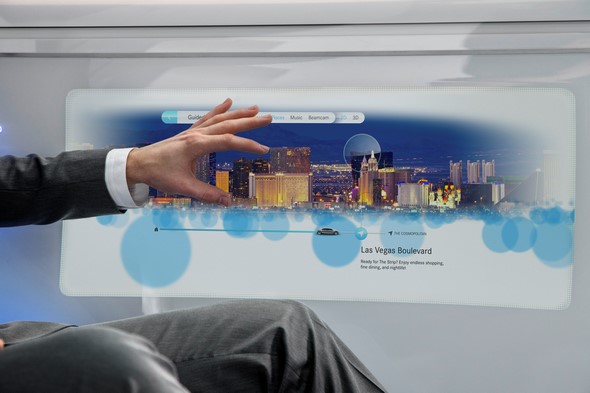
Will the car actually still exist in 20, 30 or 40 years’ time?
Kohler: I am sure of it. The motor car remains the epitome of freedom of personal mobility, because it is simply unsurpassed for comfort and privacy.
You can also see the increasing level of car ownership in countries such as India or China, where the economy and wealth are booming. There is very high demand for personal mobility there too.
Weber: In fact, it’s the new technologies that will help to ensure motoring does not lose any of its appeal in the future.
Personal mobility and modern urban planning go hand in hand. Just imagine: vehicles automatically search for parking spaces on the periphery of cities instead of increasing traffic volumes and the amount of space required in city centres due to vehicles parking.
Kohler: Certain zones in city centres could furthermore be reserved exclusively for autonomous vehicles.
That would make it possible to reduce the number of lanes in those zones and also largely do away with road signs, because they would basically be redundant. This would in turn create more room and living space for people.
Weber: It really does open up many new and interesting possibilities in terms of urban infrastructure and, of course, for the cities too, which will be able to put themselves in a good position through smart, anticipatory planning.
To put it in a nutshell: we are absolutely convinced of the tremendous potential of autonomous driving and see it as holding a highly promising future for the motor car.
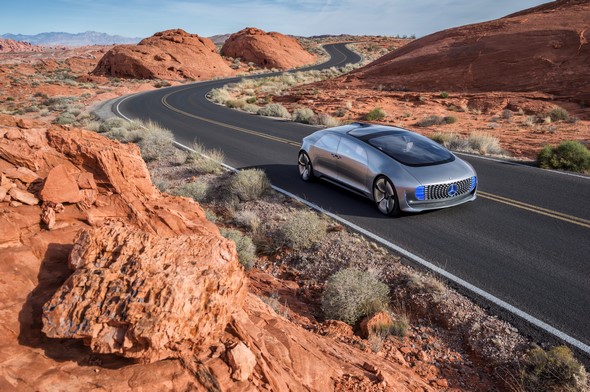
The design
Expressive forerunner of a mobility revolution
- Autonomous driving opens up new freedoms in design
- Monolithic exterior with a high-tech feel
- Flowing transitions characterise the lounge-like interior
The task of the designers of the Mercedes-Benz F 015 Luxury in Motion was to come up with a completely new concept and design for a luxury saloon: Because autonomous driving will create a lot of freedoms of design that can be utilised systematically.
The car becomes a precious, private retreat, particularly in urban traffic.
Thus the visionary research vehicle Mercedes-Benz F 015 Luxury in Motion was born, a vehicle which raises comfort and luxury to a new level by offering a maximum of space and a lounge character on the inside.
Every facet of the F 015 Luxury in Motion is the utmost reflection of the Mercedes way of interpreting the terms “modern luxury”, emotion and intelligence.
This innovative four-seater is a forerunner of a mobility revolution, and this is immediately apparent from its futuristic appearance.
Sensuousness and clarity, the core elements of the Mercedes-Benz design philosophy, combine to create a unique, progressive aesthetic appeal.
It is immediately apparent that the F 015 represents the vision of a brand new vehicle concept just from its unusual proportions, with a length of 5220 millimetres, width of 2018 millimetres and height of 1524 millimetres, from its seamless, monolithic exterior and from its large LED light modules at the front and rear.
A range of different lighting functions can be provided through these extensive LED fields. At the same time, the vehicle communicates and interacts with the outside world by means of these LED fields.
The display signals to pedestrians that the F 015 has “seen” them. The number plate is replaced by a QR code, making information on the vehicle available to the outside world.
This, along with the striking narrow luminescent band on the rear end, makes the vehicle into a “communications centre” on wheels.
The monolithic impression is emphasised by the absence of exterior mirrors and the flush-fitting side windows, which have an almost mirror-like appearance thanks to their finely-patterned surface and which blend almost imperceptibly into the flanks of the vehicle body, finished in alubeam.
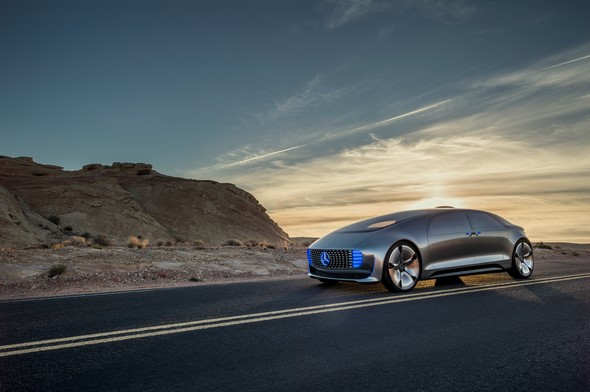
Dynamic: an extended, flowing silhouette and pronounced body shape
The low-slung front end, smooth and streamlined roof line, flat front windscreen and road-hugging rear end give the F 015 Luxury in Motion an extended and decidedly dynamic silhouette.
The vehicle body has a pronounced, attractive shape. The generously-sized areas of outer skin fit snugly to the body.
The greenhouse is tapered sharply towards the rear, resulting in muscular shoulders which lend an eye-catching contour to the flanks.
Together with the powerful-looking side skirt, this gives the sides of the vehicle additional visual structure.
The extremely large 26-inch wheels appear to push down the side skirts, which in turn emphasises the unusually long wheelbase.
The alloy wheels are split into five equally-sized, cross-drilled areas of gleaming aluminium.
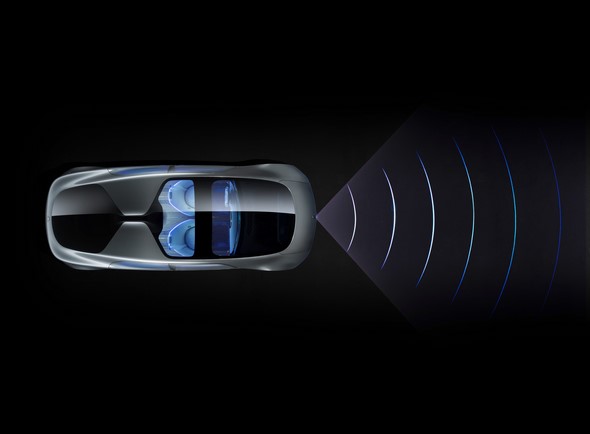
Expansive: long wheelbase and “saloon doors” that open wide
The unusually long wheelbase of the F 015 Luxury in Motion, at 3610 millimetres, is longer by some 245 millimetres than the Mercedes-Maybach S-Class (3365 millimetres).
Combined with the short overhangs, it is immediately apparent that the design focus was on providing the maximum possible space for the passengers.
The F 015 Luxury in Motion does not have any B-pillars. This fact, together with the wide-opening “saloon doors” that open out the other way to conventional doors, makes getting into and out of the vehicle interior particularly convenient and comfortable.
The doors open to a full 90 degrees. This allows a clear view of the generously dimensioned and intelligently laid out interior and ensures problem-free entry.
The side impact protection features have been cleverly integrated into the door system.
Open space: a luxury lounge providing the highest levels of comfort
In the interior of the F 015 Luxury in Motion the designers have created a lounge-like space with a feel-good ambience characterised by elegance, quality and lightness.
Sensual, flowing transitions and warm, organic materials such as open-pore walnut wood, which has been shaped to a three-dimensional veneer, and extremely soft ice-white nappa leather contrast with clearly-defined metal and glass surfaces with a cool and technical feel.
The transitions between organic, metal and synthetic materials have been designed using matrix graphics; and the flowing transitions deliver a new, unparalleled feeling of bounteous space.
The light-coloured fine wood used for the floor, for example, flows almost imperceptibly into the cool Plexiglass of the side panels thanks to their unusual surface matrix.
The transition between the vehicle floor and the door panels also echoes the outer body shape in a characterful way.
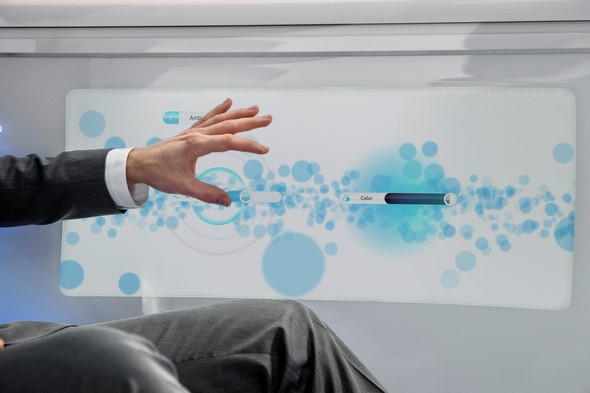
Variable and comfortable: Lounge-like seating system with a vis-à-vis configuration
The pivotal feature of the innovative interior concept is the variable seating system, with four rotating lounge chairs that allow a face-to-face seat configuration.
This enables the front passengers to turn around and talk directly to the other passengers while on the move – or to focus their attention towards the front as necessary for manual driving.
For this, the white leather steering wheel automatically slides out of the instrument panel – also clad in white leather – and offers the driver a choice of driving options.
To make getting in and out of the vehicle really comfortable, the electrically-powered seats swivel 30 degrees towards the doors as these are opened.
The cushions of the lounge chairs are upholstered in extremely soft ice-white nappa leather and set in curved mounts of highly-polished aluminium.
Each seating mount has a contrasting light band of blue LED lights and can also be manually swivelled.
Harmonious touches are provided by the leather head restraints with the Mercedes star strikingly embossed in them, as well as by the seat belts, which are in the same colour as the seat cushions.
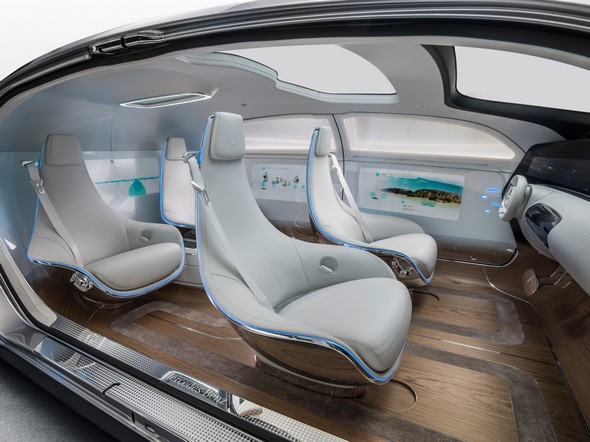
Communicative and interactive: the interior as a digital living space
One core theme of the innovative interior concept is a continuous exchange of information between vehicle, passengers and the outside world.
Six displays are installed to this end all around, tastefully mounted in the instrument panel and the rear and side walls, making the interior of the F 015 Luxury in Motion a digital living space – a perfect symbiosis of the virtual and the real world.
Passengers are able to interact intuitively with the connected vehicle by means of gestures or by touching the high-resolution screens.
Sensors recognize the passengers’ hands and offer them user interfaces within convenient reach that present the suitable operating options for the particular situation.
Particle streams on the displays – with brilliant white background graphics – visualise the vehicle’s movement and symbolise its intelligence.
In addition, individual displays for each seat provide an innovative way for passengers to take in information.
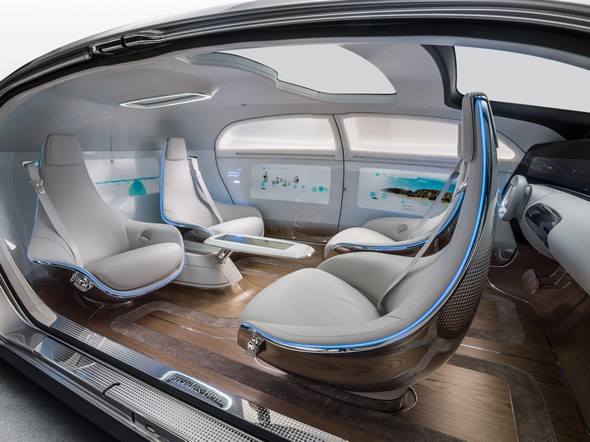
Interview with Vice President Design Gorden Wagener
“The highest expression of emotion and intelligence”
Mr Wagener, when you look back at the conceptual phase – what were the key parameters for the F 015 Luxury in Motion?
Taking as our premise the concept of autonomous driving, we came up with the vision of a car which in the guise of a large, very progressive and highly aesthetic saloon makes the hallmark Mercedes concept of “modern luxury” tangible in all its facets.
We wanted to design a luxurious vehicle with a lounge-like ambience in the interior, which combines sensuality with purity in a very special way and appeals equally to the intellect and to the emotions, thereby exerting a natural appeal.
In addition, its exterior had to signal its visionary and pioneering character at first glance.
New design freedoms – how did the design team use them?
The F 015 Luxury in Motion demonstrates an extremely progressive design idiom with its elongated mono volume. The total integration of the ‘Space Flow’ profile is revolutionary.
A taut line runs from the grille over the roof into the tail end, and thus integrates the classic components bonnet, cabin and boot into one volume.
In the interior we had the freedom to create generous space with a luxurious, modern lounge character, which thanks to displays integrated all around makes a continuous exchange of information between the vehicle, the passengers and the outside world possible.
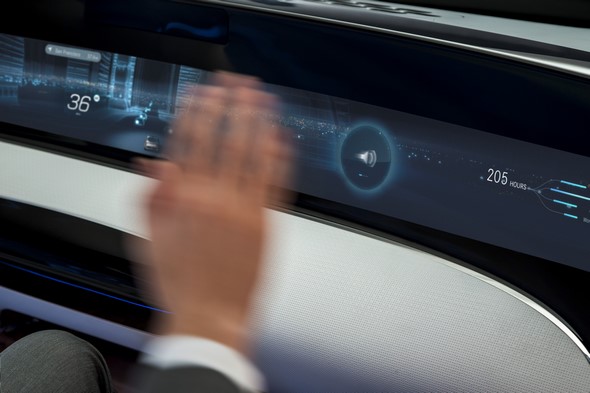
What are the core design elements that make the new research vehicle from Mercedes-Benz unmistakeable?
With our design idiom of sensuous clarity we have created unique progressive aesthetics. In addition to the complete integration of the ‘Space Flow’ profile, it is above all the unusual proportions that make the F 015 Luxury in Motion immediately unmistakable.
The front-end design also leaves not the shadow of a doubt that this is an entirely new kind of vehicle.
All lighting functions are combined within a dominant Mercedes radiator grille contour.
This gives us the opportunity to widen the grille as a trademark across the entire front, and thus to design it prominently as a stand-alone styling element.
What’s more: it makes it usable as a digital display at the same time.
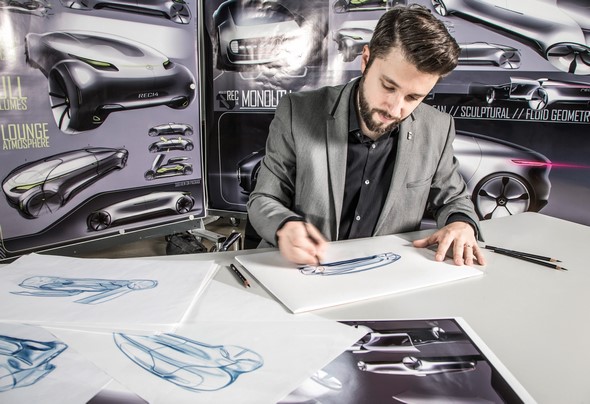
What functions did you have in mind for the LED communications field?
It has two primary functions. Firstly, the three-dimensional LED fields provide different lighting functions; and secondly, the intelligent vehicle uses them to communicate and interact with the outside world.
For example, they show whether the vehicle is currently in blue – autonomous – driving mode or white – manual – driving mode; or when a pedestrian has been registered on the edge of the road.
The large LED module at the rear offers the same communication capability for traffic following the vehicle.
On the outside, the F 015 Luxury in Motion comes across as a monolithic, sculpture-like object. How did the design team give it this character?
We were able to create the monolithic appearance of the exterior – as if hewn from a single piece – in particular through doing without conventional windscreen and window design.
The flush-fitting side windows have an almost mirror-like appearance thanks to their extremely finely-patterned surface.
As they are close in colour to the cool, technical appearance of the alubeam paint finish of the vehicle body, the transition from the windows to the bodywork is almost imperceptible.
In addition, there are neither exterior mirrors nor visible A-, B- or C-pillars to interfere with the overall impression of a sensual, object-like sculpture.
Likewise, the door system is barely perceptible thanks to its fine lines. The vehicle epitomises a total reduction in an especially emotional way.
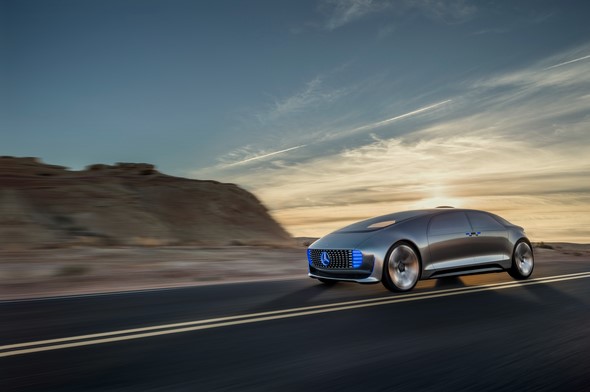
How does the design idiom of the exterior differ from that of the interior, and where do they converge?
The core concept in our design philosophy – namely the fusing of sensuousness with clarity – can be clearly seen in both the exterior and the interior.
Where the exterior was concerned, we wanted primarily to create a futuristic appearance that unambiguously and unmistakeably represented the visionary character of the F 015 Luxury in Motion.
This is done with flowing lines that stand in contrast to the monolithic, sculptured vehicle body.
In the interior we focused on comfort, an extraordinary sense of space, and the luxurious lounge character.
The displays allowing non-stop, all-round information and interaction link the analogue and digital worlds together.
The lounge chairs, through the contrasting white soft leather and highly-polished aluminium materials used, convey this fusion of sensuality with clarity in a particularly striking way.
And the innovative door system, with its wide-opening doors that open out the other way to conventional doors provides the link between exterior and interior in a very concrete way.
What is your own personal favourite detail?
The vehicle has so many highlights that it is a difficult question to answer.
I believe that in the F 015 Luxury in Motion we have created the perfect symbiosis of the virtual and the real world, and have packed the most intelligent solution in a highly aesthetic design.
With this vehicle we have defined the luxury of the future.
Curriculum Vitae
Gorden Wagener (46) has been at the helm of the globally operating design unit of Daimler AG since mid-2008. Under his leadership a new design strategy for Mercedes-Benz was developed in 2009, a strategy that is being continuously advanced.
Wagener first studied Industrial Design at the University of Essen before going on to specialise in Transportation Design at the Royal College of Art in London.
Wagener joined Daimler in 1997, was responsible for a wide variety of functions, and became head of the Mercedes-Benz US design studio in Los Angeles, California in 2006.
Interaction between passengers and vehicle
Natural and enjoyable operating experience
- Car evolves into a digital activity space
- “Extended Sense” turns the F 015 into an intelligent mobility partner
Communication and interaction between the vehicle, the passengers and the outside world is one of the key ideas behind the Mercedes-Benz F 015 Luxury in Motion.
The developers have therefore equipped the new research vehicle with an “Extended Sense” system to give it the requisite enhanced perceptual capabilities.
Thanks to this high-resolution sensor system, the vehicle keeps a constant eye on its surroundings, is capable of interpreting what it sees and taking action at any time, and relays relevant information to its passengers, depending on the specific driving situation.
This converts the F 015 into a perfectly dependable partner, while always letting the occupants make the final decision and retain overall control, if they so wish.
The interior of the F 015 Luxury in Motion is designed as a “digital activity space” that is fully connected with the outside world thanks to “Extended Sense”.
Route planning, music selection, images, contacts and many other functions can be displayed on the screens at the sides and in the rear and selected by means of proximity gestures or touch control.
A simplified reproduction of the vehicle’s surroundings can also be visualised in the displays, with the vehicle’s motion depicted in the form of streams of particles.
The functions in the front display can be operated by a novel new eye tracking function and by gestures for great ergonomic comfort.
The Mercedes-Benz F 015 Luxury in Motion thereby gives a preview of how the self-driving car of the future could become a platform for communication and interaction.
User Experience: natural and enjoyable operating experience
The Mercedes-Benz User Experience strategy seeks to wed appealing design with intuitive use.
Development of the F 015 Luxury in Motion therefore focused on the following fundamental features:
- The front display is largely operated by a combination of eye tracking and gesture control. To initiate a control function, the user first looks at the desired element in the main display. As soon as the system has detected the user’s intention by means of eye tracking, hand movements are interpreted as control inputs and it becomes possible to interact using gestures. The side displays are operated by means of proximity gestures and touch.
- The multimedia systems are seamlessly interconnected with shared content. The complete and secure connectivity with the digital world in real time enables direct access to all media without the need for time-consuming synchronisation.
- The car and its multimedia systems together with all applications and content can be preconfigured remotely by means of a specially developed app. For instance, it is possible to instruct the F 015 to park itself.
- Top-quality sound and high-resolution screens with individual crystal sharp displays for all seats make information uptake easy. During the journey, the surroundings are depicted on the displays in the form of “intelligent” streams of particles. This gives the occupants a sense of the vehicle’s motion.
360-degree all-round view: Extended Sense
With “Extended Sense”, the F 015 monitors its surroundings in every direction. Stereo cameras, as well as radar and ultrasonic sensors relay extensive data.
High-precision GPS data together with the extremely accurate 3D navigation maps make sure the position can be pinpointed to the exact centimetre.
This means the vehicle knows its precise location at all times. Critical traffic situations, such as a potential collision, are detected at an early stage by “Extended Sense”, correctly interpreted and averted by taking appropriate action.
The F 015 Luxury in Motion identifies its owner or authorised user by means of their smartphone or wearable device.
Once the user has been authenticated, the saloon-type doors open automatically and the seats swivel into a position for getting in with the greatest of ease.
The opening procedure can also be initiated from outside the vehicle using the mobile device or by touch control.
The vehicle only grants access to the interior with the correct digital “key”.
Once they have gained entry, the authorised person is also cleared to operate and control the vehicle.
Driving-specific functions, such as the desired speed or turning, overtaking and braking, can be governed using a virtual control module if required.
Digital activity space for information and interaction
Displays are installed all around the interior for visualising information and interacting with the vehicle.
The neatly integrated screens with crystal clear ultra-HD resolution turn the interior into a digital activity space on wheels.
All-round visual information is provided by the wide main screen in the digital dashboard, a Head-up Display in the windscreen area, touch-sensitive screens running the entire width of the door trim panels, as well as a screen positioned between the rear seats at head height and a table with an extending display.
The display units inside the F 015 in detail:
- The main display in the dashboard shows the driving-related information and operating menus. Functions such as vehicle speed, navigation, climate control, ventilation and the infotainment system volume can be controlled by gestures here. The captured image of the surroundings along the route, including other vehicles, other road users and stationary objects, also appears here, starting off as abstract moving data points that look like particles, in the vehicle’s immediate vicinity, then taking the concrete form of a car or pedestrian, for instance.
- The Head-up Display in the windscreen area serves to flash up place- and object-related content on points of interest in the surrounding area with the help of augmented reality technology. This can include the street numbers of buildings, information on free parking spaces, tables available in restaurants, the occupancy of hotels or the programme for a theatre near to the vehicle’s current location. The Head-up Display additionally provides a digital picture of what’s going on right now in the vehicle’s vicinity, i.e. the detected objects and road users.
- The screens in the sides of the vehicle are used for showing information, for an atmospheric display of the “intelligent” particles and for passenger interaction. They are operated by means of a touch control function combined with a proximity sensor system. This detects the respective hand movement and opens the corresponding menu in response. The user then touches the screen directly to select the specific operating function.
- The screen between the rear seats is positioned at head height and is designed as an Enhanced Rear Window. An artificial horizon with a defined vanishing point appears here that gives the occupants a sense of the vehicle’s movement.
- The rear table with extending touch-sensitive display is positioned between the rear seats and points towards the centre of the vehicle, so that it can be used by all four passengers for games or video conferences.
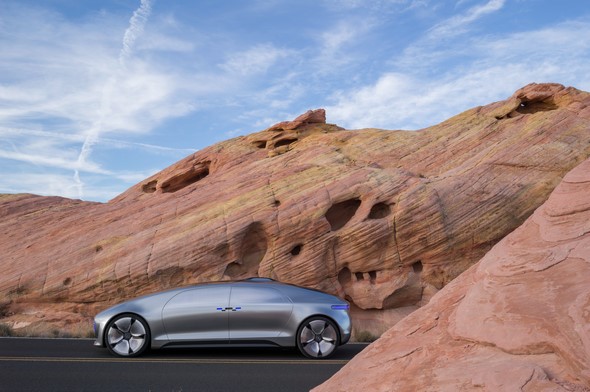
Journey into virtual worlds – rethinking personalisation
The side displays in the F 015 Luxury in Motion offer its passengers a wealth of options for transporting the outside world into the car and interacting with it.
Besides accessing personal address books or playlists of favourite music, the vehicle’s route can be displayed as a timeline including points of interest.
The lighting and colour mood can also be individually adjusted. The occupants of the F 015 furthermore have the option of superimposing various digital natural landscapes on the side displays, including forests, mountains, lakes and coastlines.
Other virtual worlds can likewise be projected. The display of the virtual surroundings is always synchronised with the actual vehicle movement, meaning that uphill climbs or downhill descents, for example, are simulated based on the current route profile, thereby allowing the passengers to sense the vehicle’s changing motion visually too.
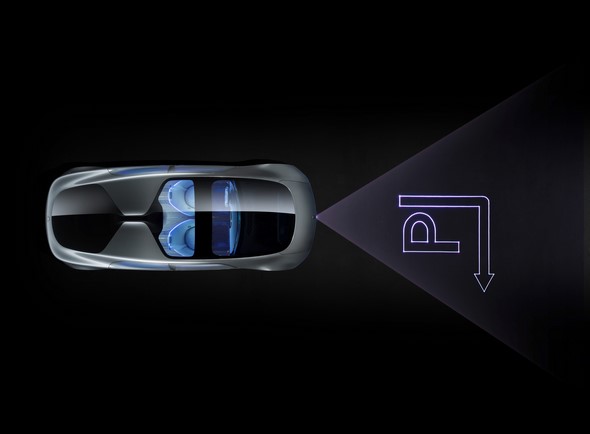
Focus on passenger well-being
Depicting the surroundings in the side displays in the form of flowing particles is also designed to boost passengers’ sense of well-being by increasing sensory comfort.
To avoid creating a hectic, turbulent impression when visualising the outside world especially, the graphics in the side displays are deliberately simplified.
A “manoeuvre flashing” function also forms part of the concept. Front passengers in the rearward-facing lounge position in particular are notified of an upcoming bend or lane change by means of ambient colour signals.
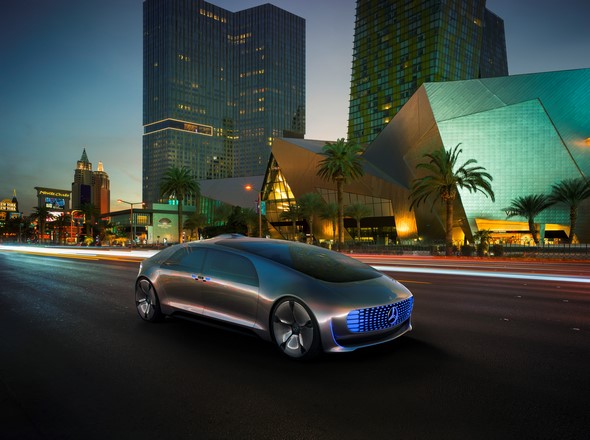
“Pick me Up” app-based service
Thanks to full connectivity at all times, the F 015 becomes an integral part of the cloud.
This means that authorised users are able to access various vehicle information and functions at any time.
For instance, the navigation, entertainment or climate control systems can be conveniently programmed from the home PC or, of course, by using a mobile device.
With the F 015 Luxury in Motion, Mercedes-Benz is once again proving itself to be a pioneer in the field of groundbreaking operating experiences that go far beyond the application of familiar consumer electronics or vehicle control concepts.
The F 015 thereby gives a preview of just how the (self-driving) car of the future could become an emotionally appealing platform for communication and interaction with its own system intelligence.
Interaction between vehicle and environment
Intelligent partner in urban traffic
- New and unique form of communication with vehicle environment
- LED displays offering added value for all road users
In the Mercedes-Benz scenario for urban traffic in tomorrow’s world, the roads are a shared space for people and vehicles.
When designing the F 015 Luxury in Motion, therefore, the focus was placed not just on providing optimum support for the passengers in its interior, but also creating added value for the people in its immediate vicinity.
Using the “Extended Sense” sensor system, the F 015 permanently monitors its surroundings in a 360-degree radius.
Stereo cameras as well as radar and ultrasonic sensors relay extensive data, which is then interpreted with the help of specially developed algorithms.
This perceptual and interpretive capability converts the F 015 into an intelligent partner for people in urban traffic.
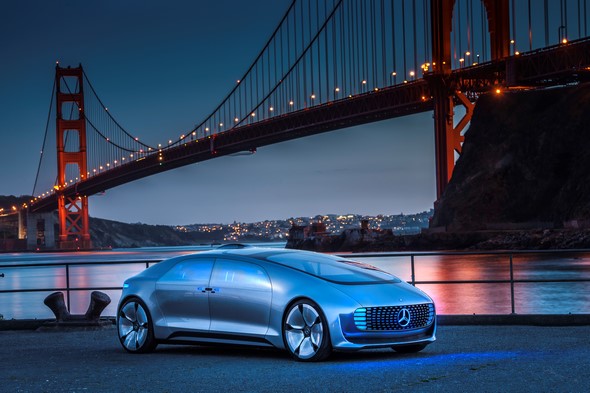
Visual and acoustic signals for greater safety
The F 015 Luxury in Motion communicates with its surroundings both visually and acoustically.
Large LED displays at the front and rear as well as a laser projection system directed toward the front are responsible for the visual part, while the acoustic communication repertoire includes both sounds and specific spoken instructions.
The displays at the front and rear feature a communication matrix comprising three-dimensional, bar-shaped LED modules, together with two outer blocks made up of large LED bars.
Information on the vehicle can be retrieved using the rear display’s integral QR code. A slim LED light strip above the rear display is used for visualising driving-specific functions such as braking, indicating and the current driving mode of the F 015.
When the vehicle is started, the LED blocks in the two communication displays light up in sequence. A special start-up sound signals that it is ready for operation.
The F 015 then uses the colour of its lights to indicate what driving mode it is currently in – blue stands for autonomous and white for manual.
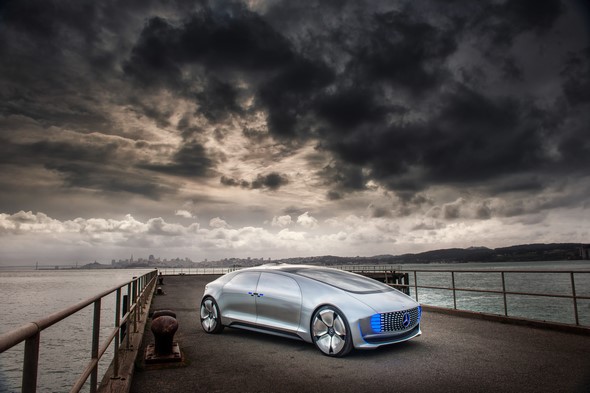
This particular information is communicated at the front by the large outer LED blocks in the grille and at the rear by the slim LED light strip.
The various LED elements that form the communication displays are individually controlled by the system.
At the front, both the light distribution and colour are varied to suit the respective situation.
Meanwhile, the rear LED display is also capable of displaying short messages for traffic behind, such as “STOP” or “SLOW”.
What’s more, the high-precision laser projection system allows the F 015 Luxury in Motion to project a broad cone of light onto the road in front showing important information.
This includes, for example, a virtual zebra crossing indicating to pedestrians on the side of the road that it is safe to cross.
And if the F 015 brakes with the intention of stopping, a suitable projected display marks the position where it will come to a stop. Other road users can then prepare themselves accordingly.
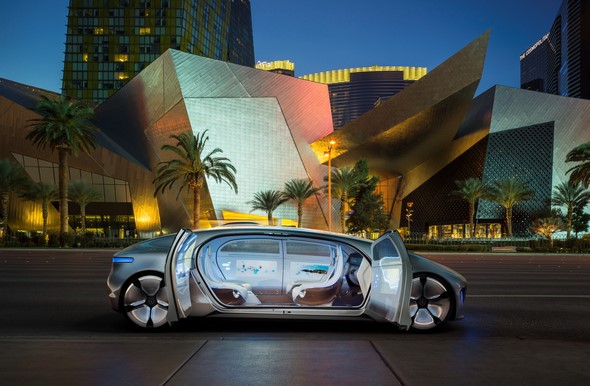
Communication with pedestrians
Should the F 015 detect a pedestrian at the roadside who wishes to cross the road in its immediate vicinity at the front, the vehicle shows an undulating light sequence on the LED communication display indicating that it will wait.
If the road is clear, the F 015 additionally emits the audible prompt “Please go ahead” to let the pedestrian know that it is safe to cross the road in front of the vehicle.
If there is a pedestrian directly in front of or behind the F 015, the car signals this with an undulating tracking light that moves across the display in synchronised fashion in the same direction the pedestrian is walking in.
This visual feedback has a similar effect to the eye contact between driver and pedestrian by allowing the F 015 to gain the trust of its human fellow road user.
Communication with traffic behind
The F 015 communicates actively with the traffic following behind using its LED rear display.
If a pedestrian is crossing the road in front of the F 015 and therefore out of sight of any vehicles that are following, the F 015 displays a sequence of red flashing lights on the rear communication display to warn the road users behind.
The additional tracking light indicates the pedestrian’s exact position on the LED display.
A flashing sequence of lights on the rear display likewise notifies traffic behind when one of the F 015 doors is about to be opened.
And when the traffic ahead of the F 015 Luxury in Motion starts to slow down, the vehicles behind likewise receive notification.
In this case, a lighting sequence runs down the rear LED element from top to bottom.
The message “SLOW” then appears for several seconds. If, on the other hand, the traffic in front of the research vehicle should unexpectedly come to a complete stop, the word “STOP” flashes repeatedly.
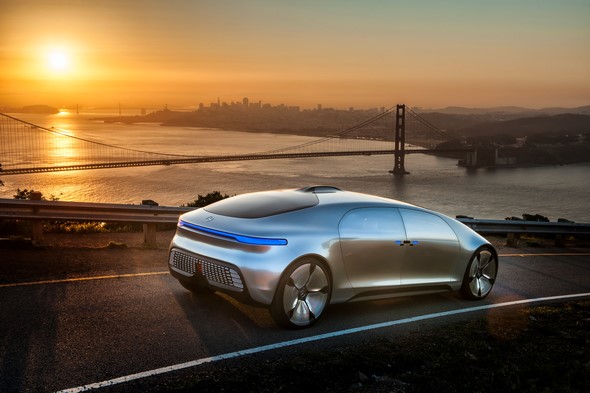
Human and machine: universal, unequivocal communication needed
The experts at Mercedes-Benz are continuing to work intensively on the devel-opment of a universal and unequivocal means of communication for interaction between human and machine.
At the “Robotics” Future Talk in 2014, numerous approaches to this issue were discussed with specialists from a variety of disciplines.
A cooperative system needs to be developed to enable social interaction between humans and machine intelligence, especially in dense urban areas.
With the new F 015 Luxury in Motion research vehicle, Mercedes-Benz is offering an outlook of how the company could envisage this communication and interaction taking place within the scope of autonomous mobility.
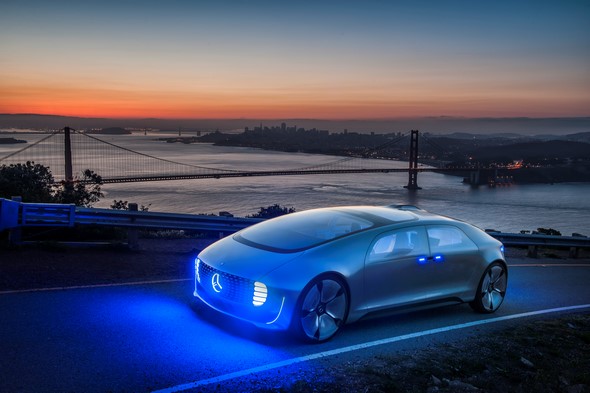
The body concept
Revolutionary vehicle structure
- Intelligent hybrid lightweight construction with innovative material mix
- Comfortable and safe door system with no B-pillar
- Safety innovations such as PRE-SAFE Structure
The high-strength body of the F 015 Luxury in Motion ensures optimum safety and supreme comfort for its passengers.
At the same time, the bodyshell’s structure provides the ideal basis for impact-protected installation of an F-CELL PLUG-IN HYBRID drive system, for the door concept that makes getting in and out especially easy, and for the communication-oriented seating featuring four lounge chairs in a face-to-face arrangement.
Mercedes-Benz currently designs standard production bodies based on the principles of “3D Body Engineering”: comprising “aero engineering”, “hybrid body engineering” and “safety engineering”, it covers the three key dimensions of body manufacture.
By employing new materials and structures, it was possible to build on this design principle and turn it into the highly efficient “Smart Body Structure (SBS)” for the F 015.
This intelligent hybrid lightweight construction, which uses the right material in the right place, combines innovative materials in a way that suits requirements, thereby maximising strength and crash safety while also optimising weight.
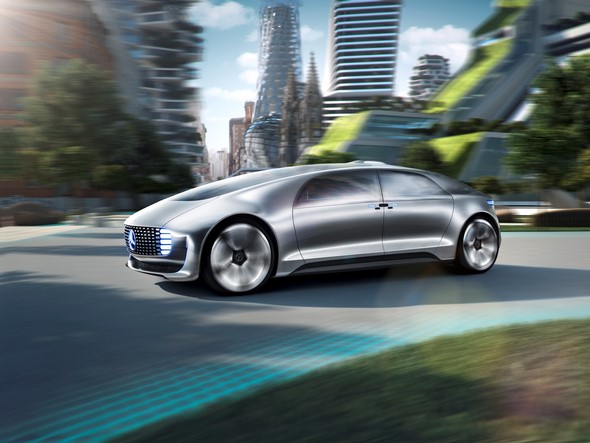
To dissipate impact energy, for example, conventional steels have been replaced by fibre-reinforced plastics (FRP), particularly those composed of carbon fibres (carbon-fibre-reinforced plastic, CFRP).
The developers were able to harness the company’s many years of experience in the world of Formula 1 here: the specific energy absorption rate of this motorsport material in an impact is four to five times higher than steel or aluminium, resulting in a far lower weight too.
This takes occupant protection into a new dimension. By cleverly combining CFRP, aluminium and high-strength steels in a way that matches the varying requirements exactly, the lightweight engineering experts were able to make the bodyshell 40 percent lighter compared to today’s production vehicles.
The Mercedes-Benz development team replaced the steel side members that have previously been the norm with plate-shaped multi-chamber sections made from an extremely light CFRP composite.
Together with additional cross-bracing above and below the firewall, this produces a highly efficient and very rigid front box unit that both carries and encloses the fuel cell, preventing components from being damaged in the event of a collision.
The impact energy is absorbed within a very short distance by the highly effective energy absorption structure before reaching the drive unit.
A similar construction can be found at the rear of the vehicle housing the two electric motors, important control units as well as high-voltage components.
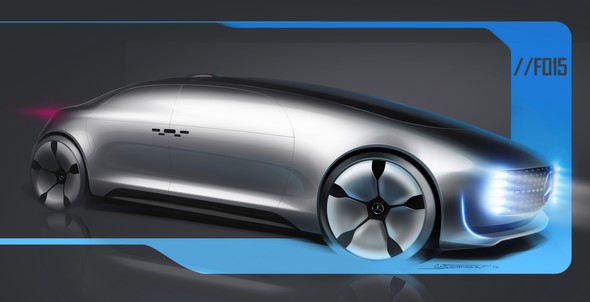
As a consequence, the F 015 Luxury in Motion affords the best possible protection not just to its passengers, but to the high-tech drive components on board too.
This is particularly true in the case of a side impact, thanks to the highly rigid occupant cell’s energy storage concept featuring a mixed CFRP/aluminium construction.
Within this ENERGY SPACE structure, the pressurised hydrogen tank system’s slim cylinders can fulfil an important role. They are made entirely of high-strength CFRP and are positioned crosswise to the direction of travel.
The cavities between the hydrogen cylinders are filled with special extremely robust structural components, thereby increasing the inherent stability of the ENERGY SPACE substantially.
The storage tanks are furthermore secured by means of special CFRP mounts with a customised cross-section, that extend for 250 millimetres beyond the left and right of each pressure cylinder.
This supplementary load path structure lets the ENERGY SPACE absorb even more impact energy without collapsing.
Together with the crash-optimised sidewalls and the aluminium/FRP construction of the side sills, this produces a high-strength vehicle assembly overall.
This sophisticated design has the two-fold benefit of bracing the body’s structure in a side impact and effectively protecting both occupants and technology alike.
Meanwhile, there is room for the pressurised hydrogen tanks, the wiring and the inductive charging unit for the high-voltage battery in the extended floor assembly.
This is also where the innovative new seating is secured that allows the passenger a vis-à-vis configuration.
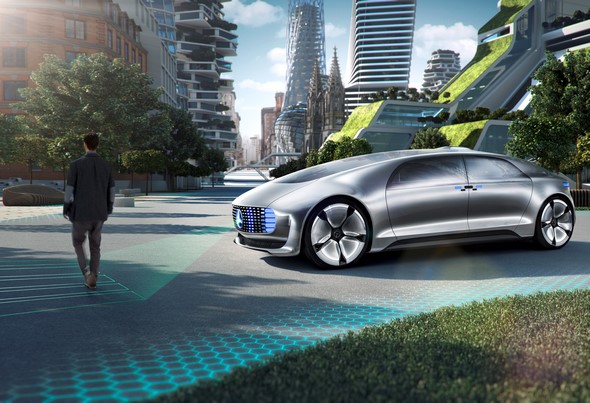
Innovative opposing door system with no B-pillar
Another key element of the body design concept is the innovative saloon-door-style system featuring rear-hinged rear doors.
The front and rear doors can be opened and closed independently of one another. All the doors open 90 degrees, allowing for very easy access to the spacious interior.
Thanks to the specially structured body, it has been possible to dispense with a B-pillar. A very sturdy interconnected system with mechanical locking elements ensures exemplary safety standards.
These elements securely interlock the front and rear doors when they are closed at the same time fixing them firmly to the roof frame and side skirts.
The resulting composite load path allows an extremely high amount of energy to be absorbed in a frontal or side impact with minimal intrusion into the passenger compartment.
To make it possible to open the front and rear doors independently, the body design experts at Mercedes-Benz developed a special double hinge for the rear doors that is attached to the C-pillar.
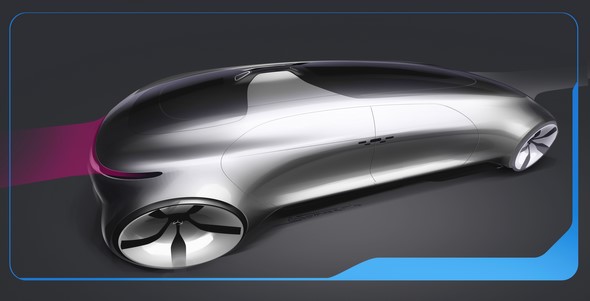
This allows the rear door to be released from the interconnected system separately with a fluid sliding movement backwards before pivoting out to open fully.
To ensure supreme comfort, all door operating mechanisms are powered electrically and fitted with obstruction sensors.
The sealing concept for the door system is the same as that used on the current Mercedes-Benz S-Class, an automatic power closing feature offers added ease of operation, plus there is that solid closing sound so typical of Mercedes.
The doors themselves have a crucial role to play in the vehicle’s passive safety concept. This is not just down to their pioneering design, featuring a bionically enhanced aluminium inner structure and an outer skin made from carbon fibre.
The crash-responsive beltlines in the doors underneath the side windows also have a vital effect.
Already unveiled on the ESF 2009 Experimental Safety Vehicle and now fitted in a more advanced version, PRE-SAFE Structure is an innovation that offers maximum safety while taking up minimum space: in a collision from the side, these bodywork elements “inflate” in an instant, just like an airbag, allowing them to absorb as much impact energy as possible.
The passengers are also given optimum protection if the vehicle should roll over: a high-strength roof frame structure in a hybrid FRP/steel construction extends from the front right through to the C-pillar at the rear.
The rear section of the roof is made from an aluminium mesh structure offering high structural rigidity and energy absorption on the one hand and low weight on the other.
A team of experts from a whole variety of technical disciplines together developed the groundbreaking bodyshell and ENERGY SPACE concept using state-of-the-art development and evaluation tools.
The powertrain engineering
1100 kilometres of zero-emission driving
- Superb performance, complete suitability for everyday use, top comfort
- More volume: structurally integrated pressurised hydrogen tanks
The F 015 Luxury in Motion was designed to allow integration of an electric drive system with fuel cell.
This is based on the pioneering F-CELL PLUG-IN HYBRID system seen in the F 125! research vehicle from 2011, and combines on-board generation of electricity with an exceptionally powerful and compact high-voltage battery.
In order to store the hydrogen the concept offers pressurised tanks made from carbon-fibre-reinforced plastic (CFRP).
Whenever the driver wishes to summon maximum power or extend the overall range, the battery is used as an additional energy source.
The battery can be recharged by using non-contact induction technology. This convenient, non-contact charging method can be monitored and controlled using a smartphone.
The electric hybrid system has a total range of 1100 kilometres, including around 200 kilometres of battery-powered driving and around 900 kilometres on the electricity from the fuel cell.
This enables the F 015 Luxury in Motion to cover distances similar to those of a comparable diesel-engined car, but purely on electric power with zero local emissions.
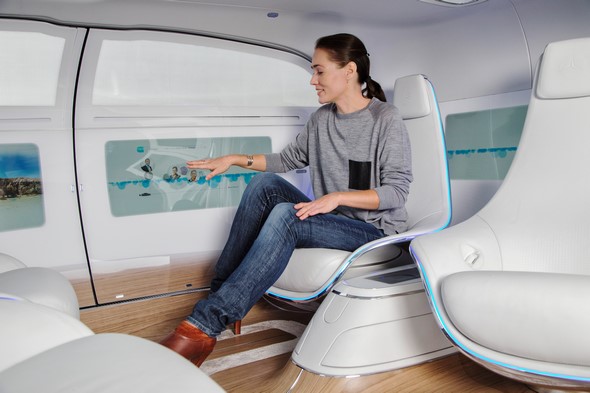
Enhanced fuel cell system
The fuel cell stack on the F 015 has been further optimised in terms of performance, efficiency and durability, and delivers the traction current for two electric motors, each with an output of 100 kW (136 hp).
These are installed in a compact arrangement in the rear end of the vehicle and transmit their drive power to the rear wheels.
The electrical drive system generates a total peak power output of 200 kW (272 hp).
The maximum torque of 200 Nm per motor is available the instant the vehicle starts off, which results in impressive acceleration: the F 015 completes the sprint from 0 to 100 km/h in 6.7 seconds and goes on to reach a governed top speed of 200 km/h.
Its consumption equates to just 0.60 kilograms of hydrogen per 100 kilometers, the equivalent of 2.0 liters of diesel.
(All consumption figures are combined figures measured in accordance with the NEDC New European Driving Cycle).
Fuel cells generate electricity from the reaction between hydrogen and oxygen. While working to further improve the fuel cell system, the overriding objective of the Mercedes-Benz engineers was to double the power output without changing the compact overall size.
Their efforts focused on the possibility of increasing the speed of the chemical reaction within the system.
This was achieved thanks to an array of individual measures, such as the innovative platinum catalytic converter coating using homogeneous nanoparticles of optimum size, and reduction of the electrical resistance in the stack’s layers of cells.
An improved electric turbocharger increases the airflow rate and thereby speeds up the chemical reaction.
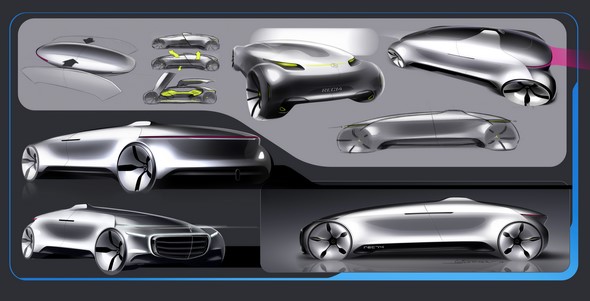
More volume: structurally integrated pressurised hydrogen tanks
The F 015 Luxury in Motion stores the hydrogen for generating electricity in 700 bar tanks that can be integrated into the floor of the car to keep them protected from impacts.
The extremely slim pressure cylinders hold 5.4 kilograms of hydrogen in total and are made from carbon-fibre-reinforced plastic (CFRP).
Thanks to their small diameter, the pressure cylinders can be fitted horizontally into the F 015 floor without encroaching on the space for the passengers in the vehicle interior.
Besides taking up very little space, the pressurised hydrogen tank system in the F 015 Luxury in Motion offers other benefits too.
It allows fast hydrogen refuelling in just a few minutes and is compatible with the H2 filling station standard used today.
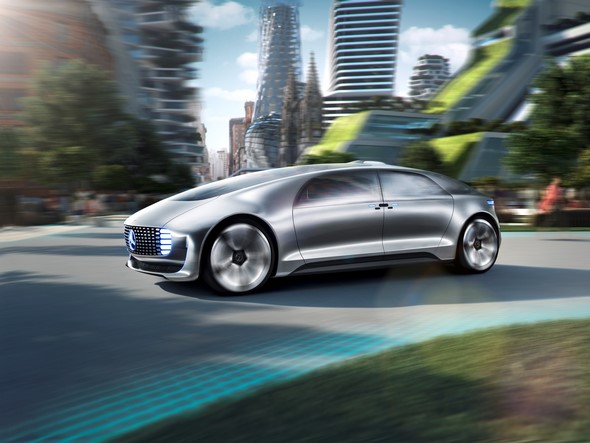
Compact high-voltage battery with high energy and power density
The ultra-compact high-voltage battery can be installed in the front end of the vehicle together with the fuel cell system and has a capacity of 29 kWh.
This amount of energy content gives the vehicle an electric range of approx. 200 kilometres when travelling purely on the battery’s power, and can also briefly boost the drive system’s power output when accelerating, for example.
With 450 Wh and 1.2 kW per litre, it would make it equally suitable for use in series production in both PLUG-IN HYBRID and all-electric vehicles.
By recuperating energy when coasting and braking, the high-voltage battery can be recharged during the journey, further improving the excellent energy efficiency of the system as a whole.
Technical data for F-CELL PLUG-IN HYBRID drive system F 015 Luxury in Motion
| Peak output of rear motors (kW/hp) | each approx. 100/136 |
| Torque of rear motors (Nm) | each approx. 200 |
| Total sustained output (kW/hp) | 120/163 |
| Total peak output (kW/hp) Continuous output from the fuel cell (kW) Maximum output from the battery (kW) | 200/272 120 80 |
| Acceleration 0-100 km/h (s) | 6.7* |
| Acceleration 60-120 km/h (s) | 6.2* |
| Top speed (km/h) | 200* |
| Hydrogen consumption (kg/100 km) | 0.60** |
| CO2 comb. (g/km min./max.) | 0 |
| Total range acc. to NEDC (km) | 1100 |
| Capacity of pressurised H2 tanks (kg) | approx. 5.4 |
| Energy content of battery (kWh) | 29 |
*target figures
**equivalent to 2.0 l diesel as per NEDC
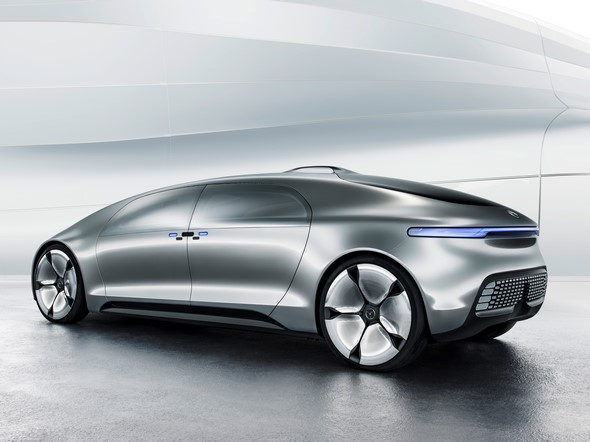
Inventing the motor car for the second time
The road to autonomous driving
- S 500 INTELLIGENT DRIVE: following autonomously in the tracks of Bertha Benz
- Future Truck 2025: driving itself on the motorway
- Semi-autonomous driving functions already available today
- Extensive connectivity to facilitate autonomous mobility
The mobility revolution will take place in evolutionary steps. As it progresses from the self-propelled (“automotive”) to the self-reliant (“autonomous”) car, Mercedes-Benz is continuously raising standards of comfort for passengers and improving safety for all road users.
Even now, vehicles from Mercedes-Benz are capable of detecting many different hazardous situations out on the road and reacting as the situation demands – by means of autonomous braking, for instance.
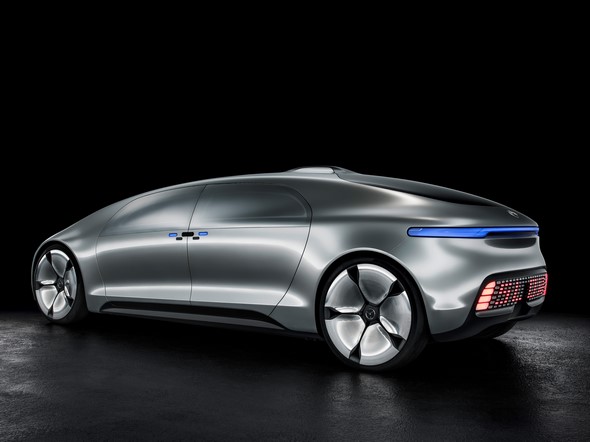
And from the C-Class through to the S-Class, there are already Mercedes-Benz models equipped with features for semi-autonomous driving on public roads today with the help of DISTRONIC PLUS with Steering Assist and Stop&Go Pilot that is able to follow vehicles in a traffic jam semi-autonomously.
Active Parking Assist with PARKTRONIC allows automated parking with active steering and brake control in both parallel and end-on spaces.
The system indicates the necessary driver actions, such as selecting the right gear, in the display.
Responsibility still rests at all times with the driver, who also has the option of switching off or overriding the driver assistance systems.
In the years to come, Mercedes-Benz will continue to push ahead with the evolution towards autonomous and accident-free driving with more new or enhanced assistance systems.
In late 2012, the brand with the star coined the term “Mercedes-Benz Intelligent Drive” to refer to all assistance systems combining maximum comfort with the greatest possible safety for passengers and other road users.
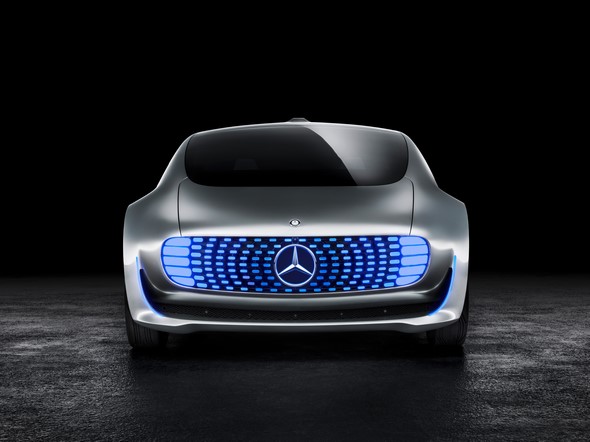
Amalgamating the data from the system of environment sensors, for example cameras as well as multi-stage radar sensors and ultrasonic sensors, is a decisive factor here.
The safety experts from Mercedes-Benz dub this networking of the various systems “sensor fusion”.
Intelligent algorithms analyse the sensor data in order to detect and pinpoint the position of vehicles that are ahead, crossing or approaching from the rear, and even from the front, within a large field of vision.
The technology identifies pedestrians, animals, road markings and a variety of traffic signs too.
Besides all-round protection for the vehicle’s own occupants, the aim is to enhance safety for other road users as well.
Mercedes-Benz sees the detection and analysis of all environmental factors as the crucial requirement for all autonomous functions in the motor car.
This is further helped by ever more detailed knowledge of routes obtained from high-resolution digital maps and automatic communication with other road users and waypoints (Vehicle-to-Vehicle, Vehicle-to-Infrastructure).
S 500 INTELLIGENT DRIVE drives autonomously in the tracks of Bertha Benz
Autonomous driving is already possible today, even in complex urban and rural traffic situations, as demonstrated to great effect by Mercedes-Benz in August 2013.
The close-to-production Mercedes-Benz S 500 INTELLIGENT DRIVE completed the approximately 100-kilometre journey from Mannheim to Pforzheim fully autonomously, following the route Bertha Benz took in 1888 on the first ever long-distance drive by car.
The self-driving S-Class with highly automated “Route Pilot” had to deal with some decidedly complex situations all on its own as it negotiated its way through heavy traffic: roundabouts, tight passing situations when driving through towns with oncoming traffic, cyclists on the road, turning manoeuvres, vehicles parked half on the road or double-parked, red traffic lights, “right-before-left” junctions, zebra crossings, pedestrians crossing the road and trams.
This groundbreaking success was achieved with the help of both close-to-production and standard production technology as well as the intelligent fusion of sensor data.

Ready for series production faster thanks to synergies between passenger car and truck development
Mercedes-Benz has underlined its role as an innovator time and time again in the truck sector too by introducing intelligent assistance systems.
At the IAA Commercial Vehicle Show in September 2014, the brand presented with the Future Truck 2025 the world’s first autonomous truck. In July 2014, this study based on the Mercedes-Benz Actros 1845 drove at speeds of up to 80 km/h in realistic traffic situations on a section of the A14 autobahn near Magdeburg.
The advances made by Mercedes-Benz with regard to the development of autonomous driving with the S 500 INTELLIGENT DRIVE research vehicle and the “Future Truck 2025” illustrate the systematic transfer of technology and the way in which optimum use is made of synergies within the Group in order to progress as fast as possible in both mobility fields.
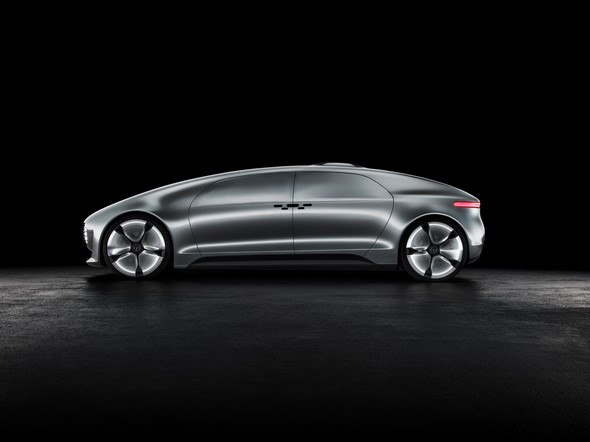
Special test facility for autonomous driving in the USA
As a global company, Mercedes-Benz has its sights set on autonomous driving worldwide.
In order to factor in the differences in traffic and infrastructure in other markets, the experts also carry out testing in the USA, for example.
In mid-September 2014, Mercedes-Benz became one of the first automotive manufacturers to be issued with an official licence by the US state of California for testing self-driving vehicles on public roads there.
In addition the company makes use of the USA’s largest test facility, the Concord Naval Weapons Station (CNWS).
This site has a network of metalled roads similar to that of a city of around 8.5 km2, and is therefore the ideal location for testing autonomous vehicles in the most realistic traffic environment possible.
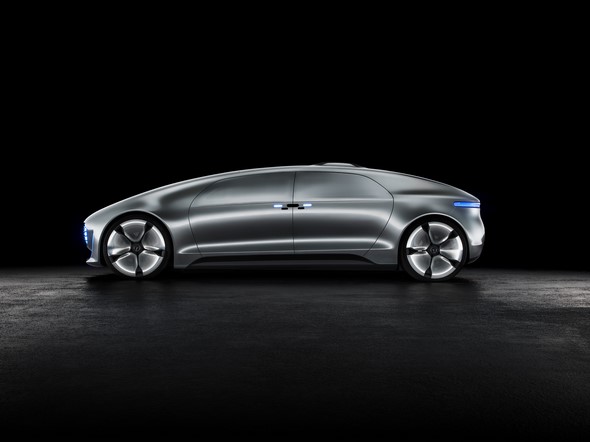
Milestones in the development of assistance systems with partially automated driving functions in production vehicles
- DISTRONIC/DISTRONIC PLUS adaptive cruise control (1998/2005)
Launched in 1998 and further developed in 2005 with improved radar sensors, this adaptive cruise control automatically maintains a safe distance from the vehicle in front. It is capable of autonomous braking and acceleration.
- PRE-SAFE® Brake (2006)
Automatically brakes the vehicle if a risk of a rear-end collision is detected (autonomous partial and full brake application).
- Active Blind Spot Assist (2010)
Can detect whether there is a vehicle in the adjacent lane in the driver’s blind spot and can reduce the risk of collision resulting from a change of lane by applying the brakes on one side.
- Active Lane Keeping Assist (2010)
Networked with ESP®. If the driver unintentionally crosses a continuous or broken lane marking, Active Lane Keeping Assist can brake the wheels on the opposite side, thereby bringing the vehicle back into its lane.
- Active Parking Assist (2010)
Navigates the vehicle into a parking space with the help of the electromechanical Direct-Steer system. Expanded to Active Parking Assist with PARKTRONIC in 2013.
- COLLISION PREVENTION ASSIST (2011)
This standard system introduced on the new B-Class issues a warning when it detects the risk of a rear-end collision.
- DISTRONIC Plus with Steering Assist and Stop&Go Pilot (2013)
Helps the driver not only to keep at a safe distance from the vehicle in front, but also to stay in the centre of their lane. This makes it possible to follow vehicles in traffic jams semi-autonomously.
- BAS PLUS Brake Assist with Cross-Traffic Assist (2013)
Capable of detecting cross-traffic and pedestrians too and boosting the braking power applied by the driver.
- COLLISION PREVENTION ASSIST PLUS (2014)
This system offers extended functionality and is capable of autonomous braking to reduce the risk of rear-end collisions.
Along the road to autonomous driving and accident-free motoring, Mercedes-Benz is continuously developing more assistance systems and getting them ready for series production step by step.
Innovations currently undergoing testing include a “Highway Pilot” that enables automated driving at higher speeds on the motorway.
Mercedes-Benz engineers are furthermore working intensively on automatic parking systems.
Extensive connectivity to facilitate autonomous mobility
Permanent connectivity and the intelligent fusion and evaluation of comprehensive sensor data are one of the next technical steps toward autonomous mobility.
One of the options for the high-speed exchange of information beyond the vehicle sensors’ field of vision is Car-to-X communication.
This is precisely the sort of new possibility for intelligent connectivity that scientists and developers deem to have great potential for expediting the advent of self-driving vehicles.
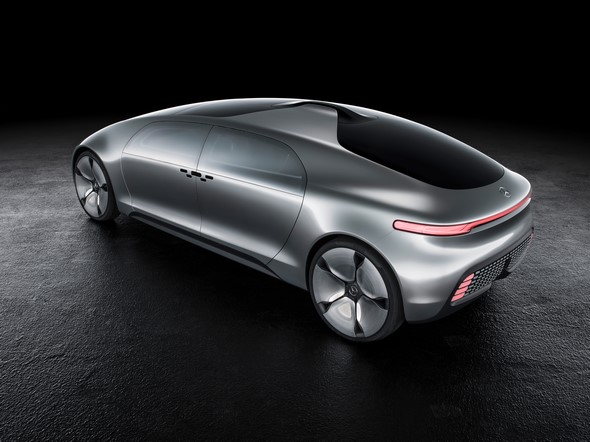
With the help of Car-to-X communication, objects or hazardous situations far beyond the vehicle’s immediate vicinity can be detected.
It makes it possible to see round corners, as it were, or through obstacles. Advance notification is given of potential traffic dangers, allowing the driver or the vehicle to ready themselves accordingly and prevent critical situations from occurring in the first place.
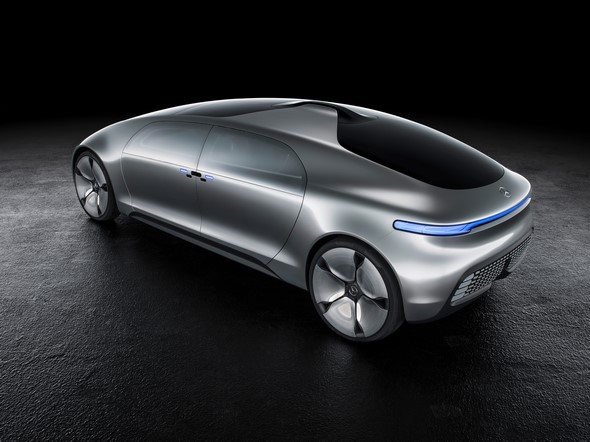
In December 2013, Mercedes-Benz became the world’s first automotive manufacturer to bring Car-to-X technology onto the roads.
The Mercedes-Benz F 015 Luxury in Motion research vehicle is far more advanced than the current production standard in all of these aspects.
By offering a vision of autonomous driving in the future in the shape of a luxury saloon with total connectivity, the F 015 provides a concrete outlook of what will be possible tomorrow today.



















